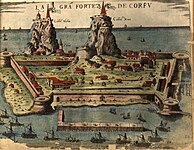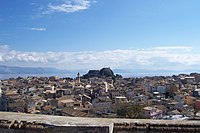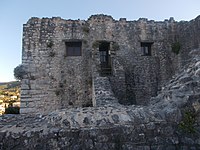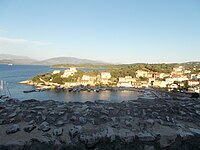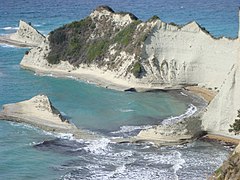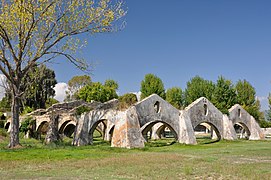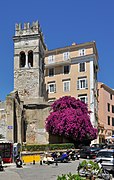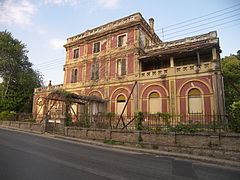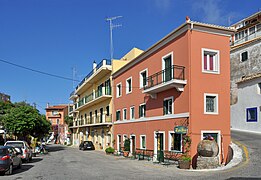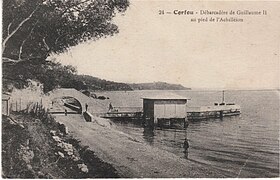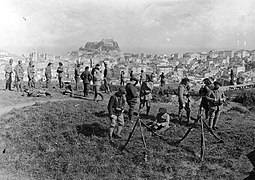Corfu
Native name: Κέρκυρα Nickname:Το νησί των Φαιάκων(The island of Faiakes) | |
|---|---|
 | |
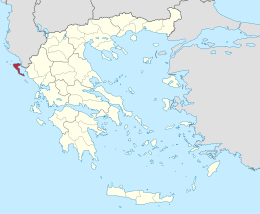 | |
| Geography | |
| Coordinates | 39°36′N19°52′E/ 39.60°N 19.87°E |
| Area | 610.9 km2(235.9 sq mi) |
| Highest elevation | 906 m (2972 ft) |
| Administration | |
| Administrative region | Ionian Islands |
| Regional unit | Corfu |
| Capital city | Corfu |
| Demographics | |
| Demonym | Corfiot,Corfiote |
| Population | 99,134 (2021) |
| Pop. density | 163.44/km2(423.31/sq mi) |
| Additional information | |
| Time zone | |
| • Summer (DST) | |
| Postal code | 490 81, 490 82, 490 83, 490 84, 491 31, 491 32 (former 491 00) |
| Area code(s) | 26610, 26620, 26630 |
| Official website | www |
Corfu(/kɔːrˈf(j)uː/kor-FEW,-FOO,USalso/ˈkɔːrf(j)uː/KOR-few, -foo) orKerkyra(Greek:Κέρκυρα,romanized:Kérkyra,pronounced[ˈcercira])[a]is aGreekisland in theIonian Sea,of theIonian Islands,[1]and, including itssmall satellite islands,forms the margin of the nation's northwestern frontier.[2]The island is part of theCorfu regional unit,and is administered by three municipalities with the islands ofOthonoi,Ereikoussa,andMathraki.[3]The principal city of the island (pop. 32,095) is also namedCorfu.[4]Corfu is home to theIonian University.
The island is bound up with thehistory of Greecefrom the beginnings ofGreek mythology,and is marked by numerous battles and conquests. AncientKorkyratook part in theBattle of Sybotawhich was a catalyst for thePeloponnesian War,and, according to Thucydides, the largest naval battle between Greek city states until that time.Thucydidesalso reports that Korkyra was one of the three great naval powers of fifth century BC Greece, along withAthensandCorinth.[5]Ruins of ancient Greek temples and other archaeological sites of the ancient city of Korkyra are located in Palaiopolis. Medieval castles punctuating strategic locations across the island are a legacy of struggles in the Middle Ages against invasions by pirates and theOttomans.Two of these castles enclose its capital, which is the only city in Greece to be surrounded in such a way. As a result, Corfu's capital has been officially declared aKastropolis( "castle city" ) by the Greek government.[6]From medieval times and into the 17th century, the island, as part of theRepublic of Venicesince 1204, successfully repulsed the Ottomans during several sieges, was recognised as a bulwark of the European States against theOttoman Empireand became one of the most fortified places in Europe.[7]The fortifications of the island were used by the Venetians to defend against Ottoman intrusion into theAdriatic.In November 1815 Corfu came under British rule following theNapoleonic Wars,and in 1864 was ceded tomodern Greeceby theBritish governmentalong with the remaining islands of theUnited States of the Ionian Islandsunder theTreaty of London.Corfu is the origin of theIonian Academy,the first university of the modern Greek state, and theNobile Teatro di San Giacomo di Corfù,the first Greek theatre andopera houseof modern Greece. The first governor of independent Greece after the revolution of 1821, founder of the modern Greek state, and distinguished European diplomatIoannis Kapodistriaswas born in Corfu.
In 2007, the city's old town was added to theUNESCOWorld Heritage List,following a recommendation byICOMOS.[8][9][10]The1994 European Union summitwas held in Corfu.[11]The island is a popular tourist destination.[12][13]
Name[edit]
The Greek name,KerkyraorKorkyra,is related to two powerful water deities:Poseidon,god of the sea, andAsopos,an important Greek mainland river.[14]According to myth, Poseidon fell in love with the beautiful nymph Korkyra, daughter of Asopos and river nymphMetope,and abducted her.[14]Poseidon brought Korkyra to the hitherto unnamed island and, in marital bliss, offered her name to the place:Korkyra,[14]which gradually evolved toKerkyra(Doric).[6]They had a child, Phaiax, after whom the inhabitants of the island were namedPhaiakes(inLatin,Phaeaciani). Corfu is known as the island of thePhaeacians.
The nameCorfùis a Venetian and Italian version of theByzantineΚορυφώ (Koryphō), meaning "city of the peaks". It derives from theByzantine GreekΚορυφαί (Koryphai) (crests or peaks), denoting the two peaks ofPalaio Frourio.[6]
Geography[edit]
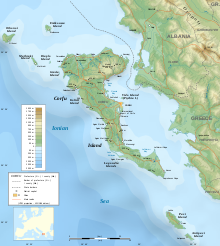
The northeastern edge of Corfu lies off thecoastofSarandë,Albania,separated by straits varying in width from 3 to 23 km (2 to 14 miles). The southeast side of the island lies off the coast ofThesprotia,Greece. Its shape resembles asickle(drepanē, δρεπάνι), to which it was compared by the ancients: the concave side, with the city and harbour of Corfu in the centre,[15]lies toward the Albanian coast. With the island's area estimated at 592.9 km2(228.9 sq mi; 146,500 acres),[16]it runs approximately 64 km (40 mi) long, with greatest breadth at around 32 km (20 mi).
Two high and well-defined ranges divide the island into three districts, of which the northern is mountainous, the central undulating, and the southern low-lying. The more important of the two ranges, that ofPantokrator(Παντοκράτωρ – the Almighty) stretches east and west from Cape Falacro to Cape Psaromita, and attains its greatest elevation in the summit of the same name.[15]
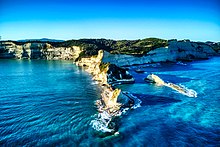
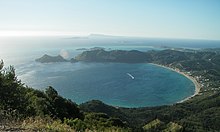
The second range culminates in the mountain of Santi Jeca, or Santa Decca, as it is called by misinterpretation of the Greek designationΆγιοι Δέκα(Hagioi Deka), or the Ten Saints. The whole island, composed as it is of various limestone formations, presents great diversity of surface.[15]Beaches are found in Agios Gordis, theKorission Lagoon,Agios Georgios, Marathia, Kassiopi, Sidari, Palaiokastritsa and many others. Corfu is located near theKefaloniageological fault formation; earthquakes have occurred.
Corfu's coastline spans 217 km (135 mi) including capes; its highest point isMount Pantokrator(906 m (2,972 ft)); and the second Stravoskiadi, at 849 m (2,785 ft). The full extent of capes and promontories take in Agia Aikaterini, Drastis to the north, Lefkimmi and Asprokavos to the southeast, and Megachoro to the south. Two islands are also to be found at a middle point of Gouvia and Corfu Bay, which extends across much of the eastern shore of the island; are known as Lazareto and Ptychia (or Vido).
Diapontia Islands[edit]

TheDiapontia Islands(Greek: Διαπόντια νησιά) are located in the northwest of Corfu, (6 km away) and about 40 km (25 mi) from the Italian coast. The main islands areOthonoi,EreikoussaandMathraki.
Lazaretto Island[edit]
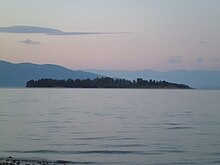
Lazaretto Island,formerly known as St. Dimitrios, is located 1.1 km (0.68 mi) off the coast northeast of the cityCorfu.Lazaretto has an area of 7.1 ha (17.5 acres) and comes under the administration of the Greek National Tourist Organization. During Venetian rule in the early 16th century, a monastery was built on the islet and a leprosarium established later in the century, after which the island was named. In 1798, during the French occupation, the islet was occupied by theRusso-Turkish fleet, who ran it as a military hospital. During the period ofBritish rule,in 1814, the leprosarium was once again opened after renovations, and followingEnosisin 1864 the leprosarium again saw occasional use.[17]DuringWorld War II,theAxis Occupation of Greeceestablished aNazi concentration campthere for the prisoners of theGreek Resistance movement,[18]while remaining today are the two-storeyed building that served as the Headquarters of the Italian army, a small church, and the wall against which those condemned to death were shot.[17][18]
Climate[edit]
Corfu has ahot-summer Mediterranean climate(Köppen climate classification:Csa) featuring hot, dry summers and mild to cool, very rainy winters, which are much wetter than otherGreek islands.[19]The highest temperature ever recorded is 42.8 °C (109.0 °F) on 24 July 2007 while the lowest is −6.0 °C (21.2 °F) on 17 January 2012.
| Climate data for Corfu (1955-2010)HNMS1 m asl | |||||||||||||
|---|---|---|---|---|---|---|---|---|---|---|---|---|---|
| Month | Jan | Feb | Mar | Apr | May | Jun | Jul | Aug | Sep | Oct | Nov | Dec | Year |
| Record high °C (°F) | 21.0 (69.8) |
23.0 (73.4) |
26.0 (78.8) |
28.0 (82.4) |
34.0 (93.2) |
41.0 (105.8) |
42.8 (109.0) |
40.0 (104.0) |
37.4 (99.3) |
33.0 (91.4) |
27.8 (82.0) |
22.0 (71.6) |
42.8 (109.0) |
| Mean daily maximum °C (°F) | 13.9 (57.0) |
14.1 (57.4) |
16.0 (60.8) |
19.1 (66.4) |
24.0 (75.2) |
28.2 (82.8) |
31.2 (88.2) |
31.5 (88.7) |
27.5 (81.5) |
23.2 (73.8) |
18.7 (65.7) |
15.2 (59.4) |
21.9 (71.4) |
| Daily mean °C (°F) | 9.8 (49.6) |
10.2 (50.4) |
12.1 (53.8) |
15.2 (59.4) |
19.9 (67.8) |
24.2 (75.6) |
26.7 (80.1) |
26.6 (79.9) |
22.7 (72.9) |
18.5 (65.3) |
14.4 (57.9) |
11.2 (52.2) |
17.6 (63.7) |
| Mean daily minimum °C (°F) | 5.3 (41.5) |
5.7 (42.3) |
7.1 (44.8) |
9.6 (49.3) |
13.3 (55.9) |
16.9 (62.4) |
18.9 (66.0) |
19.3 (66.7) |
16.8 (62.2) |
13.7 (56.7) |
10.2 (50.4) |
7.0 (44.6) |
12.0 (53.6) |
| Record low °C (°F) | −6.0 (21.2) |
−4.2 (24.4) |
−4.4 (24.1) |
−0.2 (31.6) |
4.6 (40.3) |
8.7 (47.7) |
10.0 (50.0) |
11.3 (52.3) |
7.2 (45.0) |
2.8 (37.0) |
−2.2 (28.0) |
−2.0 (28.4) |
−6.0 (21.2) |
| Average rainfall mm (inches) | 135.8 (5.35) |
123.1 (4.85) |
99.6 (3.92) |
65.2 (2.57) |
36.5 (1.44) |
15.5 (0.61) |
8.7 (0.34) |
21.7 (0.85) |
87.8 (3.46) |
140.4 (5.53) |
187.1 (7.37) |
189.9 (7.48) |
1,111.3 (43.75) |
| Average rainy days | 14.8 | 13.4 | 12.9 | 12.2 | 7.7 | 4.8 | 3.3 | 3.3 | 7.4 | 11.4 | 14.7 | 16.5 | 122.4 |
| Averagerelative humidity(%) | 75.6 | 74.1 | 73.1 | 72.5 | 69.2 | 63.2 | 61.7 | 61.7 | 70.3 | 74.9 | 77.5 | 77.1 | 70.9 |
| Mean monthlysunshine hours | 117.7 | 116.8 | 116.0 | 206.5 | 276.8 | 324.2 | 364.5 | 332.8 | 257.1 | 188.9 | 133.5 | 110.9 | 2,545.7 |
| Source 1: InfoClimat extremes 1991-present[20]
Hellenic National Meteorological Service[21] | |||||||||||||
| Source 2: NOAA (extremes and sun 1961−1990)[22] | |||||||||||||
Biodiversity[edit]
Flora[edit]
Homeridentifies six plants that adorn the garden ofAlcinous:wild olive, pear,pomegranate,apple,figandgrape vine.Of these the apple and the pear are very inferior in Corfu; the others thrive, together with all the fruit trees known inSouthern Europe,with addition of thekumquat,loquatandprickly pearand, in some spots, the banana. Olive trees dominate and their combination with cypress trees compose the typical Corfiot landscape. When undisturbed by cultivation,[15]the highmaquisis the major natural vegetation type followed by deciduous oak forests and to a lesser extent, pine forests. In total more than 1800 plant species have been recorded.[24]
Fauna[edit]
Corfu is acontinental island;its fauna is similar to that of the opposite mainland.
Birds[edit]
Avifauna is extensive, with around 300 bird species recorded since the 19th century. Species vary in size from thegreater flamingoto thegoldcrest.[25]Some species have become extinct, such as therock partridgeand thegrey partridge,or no longer breed on the island, like theeastern imperial eagle,thewhite-tailed eagle,theBonelli's eagle,thegriffon vultureand theEgyptian vulture.[26][27]
Mammals[edit]
Around 40 species of mammals live on the island and in the sea around it.Fin whales,sperm whales,Cuvier's beaked whales,common bottlenose dolphins,short-beaked common dolphins,striped dolphinsandRisso's dolphinsare the regularly present cetaceans.[28]Monk sealsappear from time to time without breeding there anymore.Eurasian ottersstill survive in the lagoons and streams of Corfu.[29][30][31]Thegolden jackalwas very common till the 1960s, but after persecution it became extinct, with the last individuals observed in the first half of the 1990s.[32][33]Recent sightings indicate a recolonization effort from the nearby mainland.[30]Wild boarswere exterminated after 2000, after farmers complained about crop damage, but at the moment they recolonized Corfu, swimming from the mainland.[30]Red foxes,beech martens,least weasels,European hares,northern white-breasted hedgehogsare quite widespread, as some of the smaller mammals like theEuropean edible dormouse,thehazel dormouse,thehouse mouse,theyellow-necked mouse,thewestern broad-toothed field mouse,thewood mouse,thelesser white-toothed shrew,theetruscan shrew,as well as several species of bats.[30][34][35]Coypus,fallow deer,red deer,Indian crested porcupines,Siberian chipmunksandraccoonshave been observed recently, but they are escapees and only the coypu and the raccoon have established viable populations.[36][30]
Amphibians and reptiles[edit]
Eight species of amphibians and 31 species of reptiles live or have been recorded on and around Corfu.[37]
TheGreek newt,theMacedonian crested newt,thecommon toad,theEuropean green toad,theEuropean tree frog,theagile frog,theEpirus water frogand theGreek marsh frogare the representatives of the Amphibia Class.
Loggerhead sea turtlesnest on the sandy beaches. On land, theHermann's tortoiseis widespread, while themarginated tortoise's status is unclear. In freshwater wetlandsEuropean pond terrapinsandBalkan terrapinsare common, but the last few years face the competition of the introducedpond slider.
Lizard species include typical lizards and geckos like thestarred agama,theMediterranean house gecko,themoorish gecko,theDalmatian algyroides,thecommon wall lizard,theBalkan wall lizard,theBalkan green lizard,theEuropean green lizardand thesnake-eyed skinkas also the legless Greek slow worm and theEuropean glass lizard.
Of the snakes of Corfu, only thenose-horned viperis potentially dangerous. The harmless snake list includes theEuropean worm snake,thejavelin sand boa,theDahl's whip snake,theBalkan whip snake,theCaspian whip snake,thefour-lined snake,theAesculapian snake,theleopard snake,thegrass snake,thedice snake,theEuropean cat snake,the easternMontpellier snake.
Butterflies[edit]
There are 75 (plus) known species of Corfiot butterfly. Of particular interest are thesouthern swallowtail,southern festoon,Oberthür's grizzled skipper,Lulworth skipper,eastern orange tip,Krueper's small white,eastern baton blueand thetree grayling,many of which are ofnear threatened status.Before the turn of the century, not much had been published about the butterfly fauna of Corfu, and there were only a few short and obscure scientific articles. Recent interest grew when a Facebook discussion page (now called Corfu Butterfly Conservation) was created on 27th April 2014. Since that time, a group of responsible butterfly enthusiasts has grown (731 members at the time of writing) who share their passion for the butterflies and moths found on the island. It is through this work that more is being discovered about the distribution and abundance of butterflies across the island.[38]
Corfu Butterfly Conservation[edit]
Corfu Butterfly Conservation (CBC) was launched in April 2019. The group is composed of concerned residents, island visitors and scientists from throughout Europe.[39]Their goals are to produce robust scientific data that can be used to influence policy and protect habitat for the benefit of Corfu's butterflies and the wider natural environment, as well as to stimulate public interest in butterfly conservation.
CBC launched its website ( corfubutterflyconservation.org, funded by theRoyal Entomological Society's Goodman Award) on the 1 January 2021 to coincide with the launch of the Corfu Butterfly Survey.[40]The website describes the 75 species of butterflies that have been confirmed by members of CBC from the island. It outlines the value of butterflies as indicators of the island's biodiversity status and encourages enthusiasts to record their sightings on this website, as participants of the survey.[38]On the 16 December 2021, CBC became a UK registeredcommunity interest company(No.13813164) and so its identity changed from being a project to that of an organisation.[38]
History[edit]
Early history[edit]

The earliest reference to Corfu is theMycenaean Greekwordko-ro-ku-ra-i-jo ("man from Kerkyra" ) written inLinear Bsyllabic script, c. 1300 BC.[41]According toStrabo,Corcyra(Κόρκυρα) was theHomericisland ofScheria(Σχερία),[42]and its earliest inhabitants were thePhaeacians(Φαίακες). The island has indeed been identified by some scholars with Scheria, the island of the Phaeacians described inHomer'sOdyssey,though conclusive and irrefutable evidence for this theory have not been found.Apollonius of Rhodesdepicts the island inArgonauticaas a place visited by the Argonauts.JasonandMedeawere married there in 'Medea's Cave'. Apollonius named the islandDrepane,Greek for "sickle", since it was thought to hide the sickle thatCronusused to castrate his fatherUranus,from whose blood the Phaeacians were descended. In an alternative account, Apollonius identifies the buried sickle as a scythe belonging toDemeter,yet the nameDrepaneprobably originated in the sickle-shape of the island. According to ascholiast,commenting on the passage inArgonautica,the island was first of all calledMacrisafter the nurse ofDionysuswho fled there fromEuboea.[43]
Some scholars have asserted that Corfu isTaphos,the island of theLelegianTaphians.[44]
According toStrabo(VI, 269), theLiburnianswere masters of the islandKorkyra(Corfu) for a time, until the 8th century BCE. They reportedly were expelled fromKorkyraby the Corinthians.[45][46][47]
At a date no doubt previous to the foundation ofSyracuse,Corfu was peopled by settlers fromCorinth,probably 730 BC, but it appears to have previously received a stream of emigrants fromEretria.The commercially advantageous location of Corcyra on the way between Greece andMagna Grecia,and its fertile lowlands in the southern section of the island favoured its growth and, influenced perhaps by the presence of non-Corinthian settlers, its people, quite contrary to the usual practice of Corinthian colonies, maintained an independent and even hostile attitude towards the mother city.[15]
This opposition came to a head in the early part of the 7th century BC, when their fleets fought the first naval battle recorded in Greek history: 665 BC according toThucydides.These hostilities ended in the conquest of Corcyra by the Corinthian tyrantPeriander(Περίανδρος) who induced his new subjects to join in the colonization ofApolloniaandAnactorium.The island soon regained its independence and thenceforth devoted itself to a purely mercantile policy. During thePersianinvasion of 480 BC it manned the second largest Greek fleet (60 ships), but took no active part in the war. In 435 BC it was again involved ina quarrel with Corinthover the control ofEpidamnus,and sought assistance from Athens (seeBattle of Sybota).[15]
This new alliance was one of the chief immediate causes of thePeloponnesian War,in which Corcyra was of considerable use to theAtheniansas a naval station, but did not render much assistance with its fleet. The island was nearly lost to Athens by two attempts of the oligarchic faction to effect a revolution; on each occasion the popular party ultimately won the day and took a most bloody revenge on its opponents (427 BC and 425 BC).[48][15]
During theSiciliancampaigns of Athens Corcyra served as a supply base; after a third abortive rising of the oligarchs in 410 BC it practically withdrew from the war. In 375 BC it again joined the Athenian alliance; two years later it was besieged by aSpartanforce, but in spite of the devastation of its flourishing countryside held out successfully until relieved. In theHellenisticperiod Corcyra was exposed to attack from several sides.[15]
In 303 BC, after a vain siege byCassander,[15]the island was occupied for a short time by theLacedaemoniangeneralCleonymus of Sparta,then regained its independence and later it was attacked and conquered byAgathocles of Syracuse.He offered Corfu as dowry to his daughterLanassaon her marriage toPyrrhus,King ofEpirus.The island then became a member of the Epirotic alliance. It was then perhaps that the settlement ofCassiopewas founded to serve as a base for the King of Epirus' expeditions. The island remained in the Epirotic alliance until 255 BC when it became independent after the death ofAlexander,last King of Epirus. In 229 BC, following the navalbattle of Paxos,it was captured by theIllyrians,but was speedily delivered by aRomanfleet and remained a Roman naval station until at least 189 BC. At this time, it was governed by a prefect (presumably nominated by the consuls), but in 148 BC it was attached to the province ofMacedonia.[49] In 31 BC, it servedOctavian(Augustus) as a base againstMark Antony.[15]
Roman and medieval history[edit]
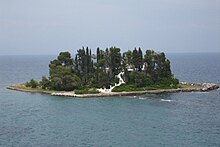
Christianity arrived in Corfu early; two disciples ofSaint Paul,Jason of Tarsus and Sosipatrus of Patras, taught the Gospel, and according to tradition the city of Corfu and much of the island converted to Christianity. Their relics were housed in the old cathedral (at the site of the current Old Fortress, before a dedicated church was built for themc. 100 AD.[50]
DuringLate Antiquity(late Roman/early Byzantine period), the island formed part of the province ofEpirus Vetusin thepraetorian prefecture of Illyricum.[51]In 551, during theGothic War,theOstrogothsraided the island and destroyed the city of Corfu, then known asChersoupolis(Χερσούπολις, "city on the promontory" ) because of its location between Garitsa Bay and Kanoni. Over the next centuries, the main settlement was moved north, to the location of the current Old Fortress, where the rocky hills offered natural protection against raids. From the twin peaks of the new site, the medieval city received its new name,Korypho(Κορυφώ, "city on the peak" ) orKorphoi(Κορφοί, "peaks" ), whence the modern Western name of "Corfu". The previous site of the city, now known asPalaiopolis(Παλαιόπολις, "old city" ), continued to be inhabited for several centuries, however.[52]
From at least the early 9th century, Corfu and the other Ionian Islands formed part of thethemeofCephallenia.[53]This naval theme provided a defensive bulwark for Byzantium against western threats, but also played a major role in securing the sealanes to the Byzantinepossessions in southern Italy.Indeed, traveller reports from throughout the middle Byzantine period (8th–12th centuries) make clear that Corfu was "an important staging post for travels between East and West".[54]Indeed, the medieval name of Corfu first appears (LatinizedCoryphus) inLiutprand of Cremona's account of his 968 embassy to the Byzantine court.[55]Corfu enjoyed relative peace and safety during theMacedonian dynasty(867–1054), which allowed the construction of a monumental church to Saints Iason and Sosipatrus outside the city wall of Palaiopolis.[55]Nevertheless, in 933, the city, led by its archbishop, Arsenios, withstood aSaracenattack; Arsenios was canonized and became the city'spatron saint.[56]
The peace and prosperity of the Macedonian era ended with another Saracen attack in 1033, but more importantly with the emergence of a new threat: following theNorman conquest of Southern Italy,the ambitious Norman monarchs set their sights on expansion in the East. Three times on the space of a century Corfu was the first target and served as a staging area for theNorman invasions of Byzantium.The first Norman occupation from 1081 to 1084 was ended only after the Byzantine emperorAlexios I Komnenossecured the aid of theRepublic of Venice,in exchange to wide-ranging commercial concessions to Venetian merchants. The admiralGeorge of Antiochcaptured Corfu again in 1147, and it took a ten-month siege forManuel I Komnenosto recover the island in 1149. In the third invasion in 1185, the island was again captured byWilliam II of Sicily,but was soon regained byIsaac II Angelos.[57]
During the break-up of theByzantine Empirethe island was occupied byGenoeseprivateers (1197–1207), who in turn were expelled by the Venetians. In 1214 it passed to the Greekdespots of Epirus,[15]who gave it toManfred of Sicilyas a dowry in 1259.[58]At his death in 1267 it passed to theHouse of Anjou.Thus, Corfu became a part of the AngevinKingdom of Albaniathat was ruled byCharles of Anjou.[59]Under the latter, the island suffered considerably from the inroads of various adventurers.[15]
The island was one of the first places in Europe in whichRomani peoplesettled. In about 1360, afiefdom,called theFeudum Acinganorumwas established, with mainly Romaniserfs.[60][61]From 1386, Corfu was controlled by theRepublic of Venice,which in 1401 acquired formal sovereignty and retained it until the French Occupation of 1797.[15]Corfu became central for the propagation of the activities of theFiliki Etaireiaamong theGreek Diasporaand philhellenic societies across Europe, through nobles likeIoannis KapodistriasandDionysios Romas.
Venetian rule[edit]

From medieval times and into the 17th century, the island was recognised as a bulwark of the European States against theOttoman Empireand became one of the most fortified places in Europe.[7]The fortifications of the island were used by the Venetians to defend against Ottoman intrusion into theAdriatic.Corfu repulsed severalOttomansieges, before passing underBritishrulefollowing theNapoleonic Wars.[62][63][64][65][66][67][68]
Kerkyra, the "Door of Venice" during the centuries when the whole Adriatic was theGulf of Venice,[69]remained in Venetian hands from 1401 until 1797, though several times assailed by Ottoman naval and land forces[15]and subjected to four notable sieges in1537,1571, 1573 and1716,in which the strength of the city defences asserted itself time after time. The effectiveness of the powerful Venetian fortifications as well as the strength of some old Byzantine castles inAngelokastro,Kassiopi Castle,Gardikiand elsewhere, were additional factors that enabled Corfu to remain free.Will Durantclaimed that Corfu owed to theRepublic of Venicethe fact that it was one of the few parts of Greece never conquered by the Ottomans.[70]
A series of attempts by theOttomansto take the island began in 1431 when Ottoman troops underAli Beylanded on the island. The Ottomans tried to take the city castle and raided the surrounding area, but were repulsed.[71]
TheSiege of Corfu (1537)was the first great siege by the Ottomans. It began on 29 August 1537, with 25,000 soldiers from the Ottoman fleet landing and pillaging the island and taking 20,000 hostages asslaves.Despite the destruction wrought on the countryside, the city castle held out in spite of repeated attempts over twelve days to take it, and the Turks left the island unsuccessfully because of poor logistics and an epidemic that decimated their ranks.[71]
Thirty-four years later, in August 1571, Ottoman forces returned for yet another attempt to conquer the island. Having seizedPargaandMourtosfrom the Greek mainland side, they attacked thePaxiislands. Subsequently they landed on Corfu's southeast shore and established a large beachhead all the way from the southern tip of the island at Lefkimi to Ipsos in Corfu's eastern midsection. These areas were thoroughly pillaged as in past encounters. Nevertheless the city castle stood firm again, a testament to Corfiot-Venetian steadfastness as well as the Venetian castle-building engineering skills. Another castle,Angelokastro,situated on the northwest coast nearPalaiokastritsa(Greek: Παλαιοκαστρίτσα meaningOld Castle place) and located on particularly steep and rocky terrain, also held out. The castle is a tourist attraction today.[71]
These defeats in the east and the west of the island proved decisive, and the Ottomans abandoned their siege and departed. Two years later they repeated their attempt. Coming from Africa after a victorious campaign, they landed in Corfu and wreaked havoc on rural areas. Following a counterattack by the Venetian-Corfiot forces, the Ottoman troops were forced to leave the city sailing away.[71]

Thesecond great siegeof Corfu took place in 1716, during the lastOttoman–Venetian War (1714–18).After the conquest of the Peloponnese in 1715, the Ottoman fleet appeared inButhrotumopposite Corfu. On 8 July the Ottoman fleet, carrying 33,000 men, sailed to Corfu from Buthrotum and established a beachhead at Ipsos.[71]The same day, the Venetian fleet encountered the Ottoman fleet off theCorfu Channeland defeated it in the ensuing naval battle. On 19 July, after taking a few outlying forts, the Ottoman army reached the hills around the city of Corfu and laid siege to it. Despite repeated assaults and heavy fighting, the Ottomans were unable to breach the defences and were forced to raise the siege after 22 days. The 5,000 Venetians and foreign mercenaries, together with 3,000 Corfiotes, under the leadership of Countvon der Schulenburgwho commanded the defence of the island, were victorious once more.[6][71][72]The success was owed in no small part to the extensive fortifications, where Venetian castle engineering had proven itself once again against considerable odds. The repulse of the Ottomans was widely celebrated in Europe, Corfu being seen as a bastion ofWestern civilizationagainst theOttomantide.[62][73]Today, however, this role is often relatively unknown or ignored, but was celebrated inJuditha triumphansby the Venetian composerAntonio Vivaldi.
Venetian policies and legacy[edit]
Corfu's urban architecture differs from that of other major Greek cities, because of Corfu's unique history. From 1386 to 1797, Corfu was ruled by Venetian nobility; much of the city reflects this era when the island belonged to theRepublic of Venice,with multi-storeyed buildings on narrow lanes. The Old Town of Corfu has clear Venetian influence and is amongst theWorld Heritage Sites in Greece.It was in the Venetian period that the city saw the erection of the first opera house (Nobile Teatro di San Giacomo di Corfù) in Greece.
Many Venetian-speaking families settled in Corfu during these centuries; they were calledCorfiot Italians,and until the second half of the 20th century theVeneto da marwas spoken in Corfu. During this time, the local Greek language assimilated a large number of Italian and Venetian words, many of which are still common today. The internationally renowned Venetian-born British photographerFelice Beato(1832–1909) is thought to have spent much of his childhood in Corfu. Also manyItalian Jewstook refuge in Corfu during the Venetian centuries and spoke their own language (Italkian), a mixture of Hebrew-Italian in a Venetian or Apulian dialect with some Greek words.
Venetians promoted theCatholic Churchduring their four centuries of rule in Corfu. Today the majority of Corfiots areGreek Orthodox,but the small Catholic minority (5%), living harmoniously with the Orthodox community, owes its faith to these origins. These contemporary Catholics are mostly families who came fromMalta,but also fromItaly,and today the Catholic community numbers about 4,000 (2⁄3of Maltese descent), who live almost exclusively in the Venetian "Citadel" ofCorfu City.Like other native Greek Catholics, they celebrate Easter using the same calendar as theGreek Orthodoxchurch. TheCathedral of St. James and St. Christopherin Corfu City is the see of theRoman Catholic Archdiocese of Corfu, Zakynthos and Cephalonia.
The island served also as a refuge for Greek scholars, and in 1732, it became the home of the first academy of modern Greece.[15]A Corfu cleric and scholar,Nikephoros Theotokis(1732–1800) became renowned in Greece as an educator, and in Russia (where he moved later in his life) as an Orthodox archbishop.
The island's culture absorbed Venetian influence in a variety of ways; like other Ionian islands (seeCuisine of the Ionian islands), its local cuisine took in such elements and today's Corfiot cooking includes Venetian delicacies and recipes: "Pastitsada",deriving from the Venetian" Pastissada "(Italian:"Spezzatino") and the most popular dish in the island of Corfu,"Sofrito","Strapatsada","Savoro "," Bianco "and" Mandolato ".
-
VenetianOld Fortress,Map 1573
-
Panoramic view ofCorfu (city)from the New Fortress
-
Detail of the south wing of the entrance at Kassiopi Castle
-
View of Kasiopi village from the castle
19th century[edit]

By the 1797Treaty of Campo Formio,Corfu was ceded to theFrench,who occupied it for two years as thedépartementofCorcyre,until they wereexpelledby a jointRussian-Ottoman squadron underAdmiral Ushakov.For a short time it became the capital of a self-governing federation of theHeptanesos( "Seven Islands" ), under Ottoman suzerainty; in 1807 after theTreaty of Tilsitits faction-ridden government was again replaced by a French administration under governorFrançois-Xavier Donzelot,and in 1809 it was besieged in vain by aBritish Royal Navyfleet, which had captured all the other Ionian islands.[15]
Following the final defeat ofNapoleonat theBattle of Waterloo,the Ionian Islands became aprotectorateof the United Kingdom by theTreaty of Parisof 5 November 1815 as theUnited States of the Ionian Islands.Corfu became the seat of the BritishLord High Commissioner of the Ionian Islands.[15]The period of British rule led to investment in new roads, an improved water supply system, and the expansion of theIonian Academyinto a university. During this period theGreek languagebecame the official language.[citation needed]
Following a plebiscite theSecond National Assembly of the Greeks at Athenselected a new king, Prince Wilhelm (William) of Denmark, who took the nameGeorge Iand brought with him the Ionian Islands as a coronation gift from Britain. On 29 March 1864, the United Kingdom, Greece, France and Russia signed theTreaty of London,pledging the transfer of sovereignty to Greece upon ratification. Thus, on 21 May, by proclamation of the Lord High Commissioner, the Ionian Islands were united with Greece.[71]
British Lord High Commissioners during the protectorate[edit]
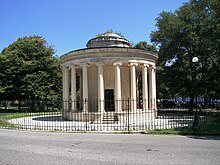
This is a list of the British High Commissioners of the Ionian Islands; (as well as the transitional Greek Governor, appointed a year prior to Enosis (Union) with Greece in 1864).[74]
- Sir James Campbell1814–1816
- Sir Thomas Maitland(1759–1824) 1815–1823
- Sir Frederick Adam(1781–1853) 1823–1832
- Sir Alexander Woodford(1782–1870) 1832
- George Nugent-Grenville, 2nd Baron Nugent(1788–1850) 1832–1835
- Howard Douglas(1776–1861) 1835–1840
- James Alexander Stewart-Mackenzie(1784–1843) 1840–1843
- John Colborne, 1st Baron Seaton(1778–1863) 1843–1849
- Sir Henry George Ward(1797–1860) 1849–1855
- Sir John Young(1807–1876) 1855–1859
- William Ewart Gladstone(1809–1898) 1859
- Sir Henry Knight Storks(1811–1874) 1859–1863
- Count Dimitrios Nikolaou Karousos, President of theIonian Parliament(1799–1873) 1863–1864
In 1891, an anti-Semiticpogrom[75]took place to oppose Jewish participation in elections.[76]Later,blood libelcaused riots,[77]it lasted three weeks and some 22 Jews died.[78]A part of the Jewish population preferred to leave the island, mainly forThessaloniki,the Ottoman territories being more welcoming. It was following these events thatAlbert Cohen's family settled inMarseille.[79]
First World War[edit]

During theFirst World War,the island served as a refuge for the Serbian army that retreated there onAlliedforces' ships from a homeland occupied by the Austrians, Germans andBulgarians.During their stay, a large portion of Serbian soldiers died from exhaustion, food shortage, and various diseases. Most of their remains were buried at sea near the island ofVido,a small island at the mouth of Corfu port, and a monument of thanks to the Greek nation has been erected at Vido by the grateful Serbs; consequently, the waters around Vido Island are known by the Serbian people as theBlue Tomb(in Serbian, Плава Гробница,Plava Grobnica), after a poem written byMilutin Bojićfollowing World War I.[80]
Interwar period[edit]
In 1923, after a diplomatic dispute between Italy and Greece, Italian forces bombarded and occupied Corfu. TheLeague of Nationssettled thisCorfu incidentin Italy's favour.
Second World War[edit]
Italian occupation and resistance[edit]

During theGreco-Italian War,Corfu was occupied by the Italians in April 1941. They administered Corfu and the Ionian islands as a separate entity from Greece until September 1943, followingBenito Mussolini's orders of fulfilling ItalianIrredentismand making Corfu part of theKingdom of Italy.During the Second World War the10th Infantry Regimentof theGreek Army,composed mainly of Corfiot soldiers,[81]was assigned the task of defending Corfu. The regiment took part inOperation Latzides,which was a unsuccessful attempt to stem the forces of the Italians.[81]After Greece's surrender to the Axis, the island came under Italian control and occupation.[81]On the first Sunday of November 1941, high school students from all over Corfu took part instudent protestsagainst the occupying Italian army; these student protests of the island were among the first acts of overt popularResistancein occupied Greece and a rare phenomenon even by wartime European standards.[81]Subsequently, a considerable number of Corfiots escaped toEpirusin mainland Greece and enlisted aspartisansinELASandEDES,in order to join the resistance movement gathering in the mainland.[81]
German bombing and occupation[edit]

Upon thefallofItalian fascismin 1943, the Nazis moved to take control of the island. On 14 September 1943, Corfu was bombarded by theLuftwaffe.The Nazi bombing raids destroyed most of the city's buildings, including churches, homes, and whole city blocks, especially in the Jewish quarter Evraiki. Other losses included the city's market (αγορά) and the hotel Bella Venezia. The worst losses were the historic buildings of theIonian Academy(Ιόνιος Ακαδημία), theMunicipal Theatre(which in 1901 had replaced theNobile Teatro di San Giacomo di Corfù), the Municipal Library, and the Ionian Parliament.[81]
Following theWehrmacht invasion,the Italians capitulated, and the island came under German occupation. Corfu's mayor at the time, Kollas, was a known collaborator and various anti-semitic laws were passed by the Nazioccupationgovernment of the island.[82]In early June 1944, while the Allies bombed Corfu as a diversion from theNormandy landings,theGestaporounded up theJewsof the city, temporarily incarcerated them at the old fort (Palaio Frourio), and on 10 June sent them toAuschwitz II,where most of them weremurdered by gas.[82][83]Approximately two hundred out of a total population of 1,900 escaped.[84]Many among the local population at the time provided shelter and refuge to those 200 Jews who managed to escape the Nazis.[85]InEvraiki(Εβραική, meaningJewish quarter), there is currently a synagogue with about 65 members, who still speak their originalItalkianlanguage.[84]
Liberation[edit]

Corfu was liberated byBritish troops,specifically the40th Royal Marine Commando,which landed in Corfu on 14 October 1944, as the Germans were evacuating Greece.[86]TheRoyal Navyswept the Corfu Channel for mines in 1944 and 1945, and found it to be free of mines.[87]A large minefield was laid there shortly afterwards by the newly communist Albania and gave rise to theCorfu Channel Incident.[87][88][89][90]This incident led to theCorfu Channel Case,where the United Kingdom opened a case against thePeople's Republic of Albaniaat theInternational Court of Justice.[91][92]
Post–World War and modern Corfu[edit]
After World War II and theGreek Civil War,the island was rebuilt under the general programme of reconstruction of the Greek Government (Ανοικοδόμησις) and many elements of its classical architecture remain. Its economy grew but a portion of its inhabitants left the island for other parts of the country; buildings erected during Italian occupation – such as schools or government buildings – were put back to civic use. In 1956Maria Desylla Kapodistria,relative of first Governor (head of state) of GreeceIoannis Kapodistrias,was elected mayor ofCorfuand became the first female mayor in Greece.[93]The Corfu General Hospital was also constructed;[94]electricity was introduced to the villages in the 1950s, the radio substation of Hellenic Radio in Corfu was inaugurated in March 1957,[95]and television was introduced in the 1960s, with internet connections in 1995.[96]TheIonian Universitywas established in 1984.
Architecture[edit]

Venetian influence[edit]
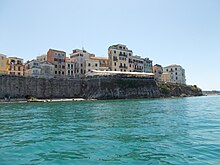
Corfu's urban architecture influence derives from Venice, reflecting the fact that from 1386 to 1797 the island was ruled by the Venetians. The architecture of the Old Town of Corfu along with its narrow streets, thekantounia,has clear Venetian influence and is amongst theWorld Heritage Sites in Greece.Other notable Venetian-era buildings include theNobile Teatro di San Giacomo di Corfù,the first Greek opera house, andListon,a multi-level commercial and residential building, with an arched colonnade at ground level, lined with cafes and restaurants on its east side, and restaurants and other stores on its west side. Liston's main thoroughfare is often the site of parades and other mass gatherings. Liston is on the edge of theSpianada(Esplanade), the vast main plaza and park which incorporates acricketfield, a pavilion, and Maitland's monument. Also notable are the Old and New forts, the recently restored Palace of Sts. Michael and George, formerly the residence of the British colonial governor and the seat of theIonian Senate,and the summer Palace ofMon Repos,formerly the property of the Greek royal family and birthplace of thePrince Philip, Duke of Edinburgh.The Park of Mon Repos is built on part of the Palaiopolis of Kerkyra, where excavations were conducted by the Greek Archaeological Service in collaboration with academics and universities internationally. Examples of the finds can be found in the Museum of the Palace of Mon Repos and at theArchaeological Museum of Corfu.[97]
The Achilleion[edit]

In 1889,Empress Elizabeth of Austriabuilt a summer palace in the region ofGastouri(Γαστούρι) to the south of the city, naming itAchílleion(Αχίλλειον) after theHomerichero Achilles. The structure is filled with paintings and statues of Achilles, both in the main hall and in the gardens, depicting scenes of theTrojan War.The palace, with theneoclassicalGreek statues that surround it, is a monument toplatonicromanticismas well asescapism.It served as a refuge for the grieving Empress following the tragic death of her only sonCrown Prince, Rudolf.

The Imperial gardens on the hill look over the surrounding green hills and valleys and theIonian sea.The centrepiece of the gardens is a marble statue on a high pedestal, of the mortally wounded Achilles (Greek:Αχιλλεύς Θνήσκων,Achilleús Thnēskōn,Achilles Dying) withouthubrisand wearing only a simple cloth and an ancient Greekhoplitehelmet. This statue was carved by German sculptorErnst Gustav Herter.
The hero is presented devoid of rank or status, and seems notably human, though heroic, as he is forever trying to pullParis's arrow from his heel. His classically depicted face is full of pain. He gazes skyward, as if to seek help fromOlympus.According toGreek mythology,his motherThetiswas a goddess.[citation needed]
In contrast, at the great staircase in the main hall is a giant painting of the triumphant Achilles full ofpride.Dressed in full royal military regalia and erect on his racing chariot, he pulls the lifeless body ofHector of Troyin front of the stunned crowd watching helplessly from inside the walls of the Trojan citadel.
In 1898, Empress Sissi was assassinated at the age of 60 by an Italian anarchist,Luigi Lucheni,inGeneva,Switzerland. After her death, the palace was sold to theGermanKaiserWilhelm II.Following the Kaiser's purchase of the Achilleion, he invited archaeologistReinhard Kekulé von Stradonitz,a friend and advisor, to come to Corfu to advise him where to position the huge statue of Achilles which he commissioned. The famous salute to Achilles from the Kaiser, which had been inscribed at the statue's base, was also created by Kekulé. The inscription read:[98]
To the Greatest Greek from the Greatest German
The inscription was subsequently removed after World War II.[99]
The Achilleion was eventually acquired by the Greek state and has now been converted into a museum.
Kaiser's Bridge[edit]

GermanKaiser Wilhelm IIwas also fond of taking holidays in Corfu. Having purchased the Achilleion in 1907 after Sissi's death, he appointedCarl Ludwig Sprengeras the botanical architect of the Palace, and also built a bridge later named by the locals after him—the "Kaiser's bridge" (Greek: η γέφυρα του Κάιζερ transliterated as: i gefyra tou Kaizer)—to access the beach without traversing the road forming the island's main artery to the south. The bridge, arching over the road, spanned the distance between the lower gardens of Achilleion and the nearby beach; its remains are an important landmark on the highway. The bridge's central section was demolished by theWehrmachtin 1944, during the German occupation of World War II, to allow for the passage of an enormous cannon, forming part of the Nazi defences in the southeastern coast of Corfu.[100][101]
Urban landscape[edit]
Old town[edit]
The Old Town ofCorfu cityis aUNESCO World Heritage Site.In several parts of the old city, buildings of theVenetianera are to be found. The old city's architectural character is strongly influenced by the Venetian style, coming as it did under Venetian rule for a long period; its small and ancient side streets, and the old buildings' trademark arches are particularly reminiscent ofVenice.
The city ofCorfustands on the broad part of a peninsula, whose termination in the Venetiancitadel(Greek:Παλαιό Φρούριο) is cut off from it by an artificialfosseformed in a natural gully, with a seawater moat at the bottom,[15]that now serves as amarinaand is called theContrafossa.In the old town there are many narrow streets paved with cobblestones. These streets are known askantoúnia(Greek:καντούνια), and the older amongst them sometimes follow the gentle irregularities of the ground; while many are too narrow for vehicular traffic. A promenade rises by the seashore towards the bay of Garitsa (Γαρίτσα), together with an esplanade between the city and the citadel known asSpianadawith theListonarcade (Greek:Λιστόν) to its west side, where restaurants and bistros abound.[1]
Ano and Kato Plateia and the music pavilion[edit]

Near the old Venetian Citadel a large square calledSpianadais also to be found, divided by a street in two parts: "Ano Plateia" (literally: "Upper square" ) and "Kato Plateia" (literally: "Lower square" ), (Ανω Πλατεία and Κάτω Πλατεία in Greek). This is the biggest square in South-Eastern Europe and one of the largest in Europe,[102][103]and replete with green spaces and interesting structures, such as a Roman-style rotunda from the era of British administration, known as theMaitland monument,built to commemorateSir Thomas Maitland.An ornate music pavilion is also present, where the local "Philharmonikes" (Philharmonic Orchestras) (Φιλαρμονικές), mount classical performances in the artistic and musical tradition for which the island is well known. "Kato Plateia" also serves as a venue wherecricketmatches are held from time to time. In Greece, cricket is unique to Corfu, as it was once a British protectorate.
Palaia Anaktora and its gardens[edit]
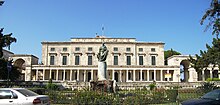

Just to the north of "Kato Plateia" lie the "Palaia Anaktora" (Παλαιά Ανάκτορα: literally "Old Palaces" ): a large complex of buildings of Roman architectural style which formerly housed the Kings of Greece, and prior to that theBritish Governorsof the island. It was then called the Palace of Saints Michael and George. TheOrder of St. Michael and St. Georgewas founded here in 1818 with mottoauspicium melioris aevi,[104][105]and is still awarded by the United Kingdom. Today the palace is open to the public and forms a complex of halls and buildings housing art exhibits, including aMuseum of Asian Art,unique across Southern Europe in its scope and in the richness of its Chinese and Asian exhibits. The gardens of the Palaces, complete with old Venetian stone aquariums, exotic trees and flowers, overlook the bay through old Venetian fortifications and turrets, and the local sea baths (Μπάνια τ' Αλέκου) are at the foot of the fortifications surrounding the gardens. A café on the grounds includes its ownart gallery,with exhibitions of both local and international artists, known locally as the Art Café. From the same spot, the viewer can observe ships passing through the narrow channel of the historicVido island(Νησί Βίδου) to the north, on their way to Corfu harbour (Νέο Λιμάνι), with high speed retractableaerofoilferries fromIgoumenitsaalso cutting across the panorama. A wrought-iron aerial staircase, closed to visitors, descends to the sea from the gardens; the Greek royal family used it as a shortcut to the baths. Rewriting history, locals now refer to the old Royal Gardens as the "Garden of the People" (Ο Κήπος του Λαού).
Churches[edit]
In the city, there are thirty-seven Greek churches, the most important of which are the city's cathedral, the church dedicated to Our Lady of the Cave (η Παναγία Σπηλιώτισσα (hē Panagia Spēliōtissa));Saint Spyridon Church,wherein lies the preserved body of the patron saint of the island; and finally the suburban church of St Jason and St Sosipater (Αγιοι Ιάσων και Σωσίπατρος), reputedly the oldest in the island,[15]and named after the two saints probably the first to preach Christianity to the Corfiots.
Pontikonisi[edit]
The nearby island, known asPontikonisi(Greek meaning "mouse island" ), though small is very green with abundant trees, and at its highest natural elevation (excluding its trees or man-made structures, such as the monastery), stands at about 2 m (6 ft 6.74 in). Pontikonisi is home of the monastery of Pantokrator (Μοναστήρι του Παντοκράτορος); the white stone staircase of the monastery, viewed from afar, gives the impression of a (mouse) tail, which lent the island its name.
Archaeology[edit]
Palaiopolis[edit]
In the city of Corfu, the ruins of the ancient city of Korkyra, also known asPalaiopolis,include ancient temples which were excavated at the location of the palace of Mon Repos, which was built on the ruins of the Palaiopolis. The temples are:Kardaki Temple,Temple of Artemis,and theTemple of Hera.Hera's temple is situated at the western limits of Mon Repos, close toKardaki Templeand to the northwest.[106]It is approximately 700 m. to the southeast of theTemple of Artemis in Corfu.[106]Hera's Temple was built at the top of Analipsis Hill, and, because of its prominent location, it was highly visible to ships passing close to the waterfront of ancientKorkyra.[106]
Kardaki Temple[edit]

Kardaki Temple is anArchaicDorictemplein Corfu,Greece,built around 500 BC in the ancient city ofKorkyra(or Corcyra), in what is known today as the location Kardaki in the hill of Analipsi in Corfu.[107]The temple features several architectural peculiarities that point to a Doric origin.[107][108]The temple at Kardaki is unusual because it has nofrieze,following perhaps architectural tendencies of Sicilian temples.[109]
It is considered to be the only Greek temple of Doric architecture that does not have a frieze.[107]The spacing of the temple columns has been described as "abnormally wide".[110]The temple also lacked bothporchandadyton,and the lack of a triglyph andmetopefrieze may be indicative ofIonianinfluence.[111]The temple at Kardaki is considered an important and to a certain degree mysterious topic on the subject of earlyancient Greek architecture.Its association with the worship ofApolloorPoseidonhas not been established.
Temple of Artemis[edit]

The Temple of Artemis is anArchaicGreek templein Corfu, built in around 580 BC in the ancient city ofKorkyra(or Corcyra), in what is known today as the suburb of Garitsa. The temple was dedicated toArtemis.It is known as the firstDorictemple exclusively built withstone.[112]It is also considered the first building to have incorporated all of the elements of theDoric architectural style.[113]Very few Greek templereliefsfrom the Archaic period have survived, and the large fragments of the group from thepedimentare the earliest significant survivals.
The temple was aperipteral–styled building with apseudodipteralconfiguration. Its perimeter was rectangular, with width of 23.46 m (77.0 ft) and length 49 m (161 ft) with an eastward orientation so that light could enter the interior of the temple at sunrise.[112]It was one of the largest temples of its time.[114]
Themetopeof the temple was probably decorated, since remnants of reliefs featuringAchillesandMemnonwere found in the ancient ruins.[112]The temple has been described as a milestone ofAncient Greek architectureand one of 150masterpiecesofWesternarchitecture.[113]The Corfu temple architecture may have influenced the design of an archaicsanctuarystructure found at St. Omobono inItaly,nearTiberinAncient Rome,at the time of theEtruscans,which incorporates similar design elements.[115]If still in use by the 4th-century, the temple would have been closed during thepersecution of pagans in the late Roman Empire,when the Christian Emperors issued edicts prohibiting non-Christian worship.Kaiser Wilhelm II,while vacationing at his summer palace of Achilleion in Corfu and while Europe was preparing for war, was involved in excavations at the site of the ancient temple.
Temple of Hera[edit]

The Temple of Hera or Heraion is anarchaictemplein Corfu, built around 610 BC in the ancient city ofKorkyra(or Corcyra), in what is known today asPalaiopolis,and lies within the ground of theMon Reposestate.[116][117][106]The sanctuary of Hera at Mon Repos is considered a major temple, and one of the earliest examples ofarchaic Greek architecture.[106]
Largeterracottafigures such as lions,gorgoneions,andDaidalamaidens, created and painted in vivid colour byartisans,who were inspired bymythtraditions across theMediterranean,decorated the roof of the temple, making it one of the most intricately adorned temples ofArchaic Greeceand the most ambitious roof construction project of its time.[106]Built at the top of Analipsis Hill, Hera's sanctuary was highly visible to ships approaching the waterfront of the ancient city ofKorkyra.[106]
TheDigital Archaic Heraion Project at Mon Reposis a project that has undertaken the task ofdigitisingthe architectural fragments found at the Corfu Heraion with the aim to reconstruct in 3D the Temple at Palaiopolis invirtual space.[118]
Tomb of Menecrates[edit]


The Tomb of Menecrates or Monument of Menecrates is anArchaiccenotaphin Corfu, built around 600 BC in the ancient city ofKorkyra(or Corcyra).[119][120]The tomb and the funerary sculpture of a lion were discovered in 1843 during demolition works by theBritish Armywho were demolishing a Venetian fortress in the location of Garitsa hill in Corfu.[121]The tomb is dated to the 6th century BC.[121]
The lion is dated at the end of the 7th century BC and it is one of the earliest funerary lions ever found.[121]The tomb and the lion were found in an area which was part of thenecropolisof ancient Korkyra, which was discovered by the British army at the time.[121]According to anAncient Greekinscription found on the grave, the tomb was a monument built by the ancient Korkyreans in honour of theirproxenos(ambassador) Menecrates, son of Tlasios, from Oeiantheia. Menecrates was the ambassador of ancientKorkyrato Oeiantheia, modern dayGalaxidiorOzolian Locris,[122][123]and he was lost at sea. In the inscription it is also mentioned that the brother of Menecrates, Praximenes, had arrived from Oeiantheia to assist the people of Korkyra in building the monument to his brother.[124][119]
Other archaeological sites[edit]
InCassiope,the only other city of ancient importance, its name is still preserved by the village of Kassiopi, and there are some rude remains of building on the site; but the temple ofZeusCassius for which it was celebrated has totally disappeared.
Castles[edit]
The castles of Corfu, located at strategic points on the island helped defend the island from many invaders and they were instrumental in repulsing repeated Turkish invasions, making Corfu one of the few places in Greece never to be conquered by the Ottomans.
Palaio Frourio[edit]
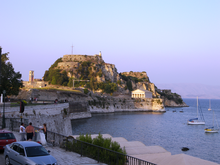

Theold citadel(in GreekPalaio Frourio(Παλαιό Φρούριο) is an old Venetian fortress built on an artificial islet with fortifications surrounding its entire perimeter, although some sections, particularly on the east side, are slowly being eroded and falling into the sea. Nonetheless, the interior has been restored and is in use for cultural events, such as concerts (συναυλίες) and Sound and Light Productions (Ηχος και Φως), when historical events are recreated using sound and light special effects. These events take place amidst the ancient fortifications, with the Ionian sea in the background. The central high point of the citadel rises like a giant naturalobeliskcomplete with a military observation post at the top, with a giantcrossat its apex; at the foot of the observatory lies St. George's church, in a classical style punctuated by sixDoriccolumns,[125]as opposed to theByzantinearchitectural style of the greater part of Greek Orthodox churches.
Neo Frourio[edit]

Thenew citadelorNeo Frourio(Νέο Φρούριο, "New Fortress" ) is a huge complex of fortifications built by the British during theirrule of the island(1815–63)[126]dominating the northeastern part of the city. The huge walls of the fortress loom over the landscape as one travels fromNeo Limani(Νέο Λιμάνι, "New Port" ) to the city, taking the road that passes through the fishmarket (ψαραγορά). The new citadel was until recently a restricted area due to the presence of a naval garrison, but old restrictions have been lifted and it is now open to the public, with tours possible through the maze of medieval corridors and fortifications. The wingedLion of St Mark,the symbol of Venice, can be seen at regular intervals adorning the fortifications.
Angelokastro[edit]

Angelokastro (Greek:Αγγελόκαστρο(Castle of Angelos or Castle of the Angel);Venetian:Castel Sant'Angelo) is aByzantinecastleon the island of Corfu,[127][128]Greece.It is located at the top of the highest peak of the island's shoreline in the northwest coast nearPalaiokastritsaand built on particularly precipitous and rocky terrain. It stands 1,000 ft (305 m) on a steep cliff above the sea and surveys theCity of Corfuand the mountains of mainland Greece to the southeast and a wide area of Corfu toward the northeast and northwest.[127][129]
Angelokastro is one of the most important fortified complexes of Corfu. It was an acropolis which surveyed the region all the way to the southernAdriaticand presented a formidable strategic vantage point to the occupant of the castle.
Angelokastro formed a defensive triangle with the castles ofGardikiandKassiopi,which covered Corfu's defences to the south, northwest and northeast. The castle never fell, despite frequent sieges and attempts at conquering it through the centuries, and played a decisive role in defending the island against pirate incursions and during three sieges of Corfu by the Ottomans, significantly contributing to their defeat. During invasions it helped shelter the local peasant population. The villagers also fought against the invaders playing an active role in the defence of the castle. Angelokastro, located at the western frontier of the Empire, was instrumental in repulsing the Ottomans during the first great siege of Corfu in 1537, in the siege of 1571 and the second great siege of Corfu in 1716 causing the Ottomans to fail at penetrating the defences of Corfu in the North. Consequently the Turks were never able to create abeachheadand to occupy the island.[130]
Gardiki Castle[edit]
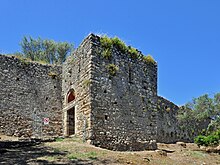
Gardiki Castle (Greek:Κάστρο Γαρδικίου) is a 13th-centuryByzantinecastle on the southwestern coast of Corfu and the only surviving medieval fortress on the southern part of the island.[131]It was built by a ruler of theDespotate of Epirus,[132]and was one of three castles which defended the island before theVenetianera (1401–1797).
The location of Gardiki at the narrow southwest flank of Corfu provided protection to the fields and the southern lowlands of Corfu and in combination withKassiopi Castleon the northeastern coast of the island and ByzantineAngelokastroprotecting the northwestern shore of Corfu, formed a triangular line of defence which protected Corfu during the pre-Venetian era.[132][133][134]
Kassiopi Castle[edit]

Kassiopi Castle (Greek:Κάστρο Κασσιώπης) is a castle on the northeastern coast of Corfu overseeing the fishing village ofKassiopi.[135]It was one of three Byzantine-period castles that defended the island before theVenetianera (1386–1797). The castles formed a defensive triangle, withGardikiguarding the island's south, Kassiopi the northeast andAngelokastrothe northwest.[133][134]
Its position at the northeastern coast of Corfu overseeing theCorfu Channelthat separates the island from the mainland gave the castle an important vantage point and an elevated strategic significance.[135]
Kassiopi Castle is considered one of the most imposing architectural remains in the Ionian Islands,[136]along with Angelokastro,Gardiki Castleand the two Venetian Fortresses of Corfu City, theCitadeland theNew Fort.[136]
Since the castle was abandoned for a long time, its structure is in a state of ruin. The eastern side of the fort has disappeared and only a few traces of it remain. There are indications that castle stones have been used as building material for houses in the area. Access to the fortress is mainly from the southeast through a narrow walkway which includes passage from homes and backyards, since the castle is at the centre of the densely built area of the small village of Kassiopi.[137][138]
Municipalities[edit]
The three present municipalities of Corfu and Diapontia Islands were formed in the 2019 local government reform from the former municipality Corfu.[3][139]
Education[edit]
Ionian Academy[edit]

TheIonian Academywas an institution that maintained the tradition of Greek education while the rest of Greece was still under Ottoman rule. The academy was established by the French during their administration of the island as thedépartementofCorcyre,[140][141]and became a university during the British administration,[141]through the actions ofFrederick North, 5th Earl of Guilfordin 1824.[142]It is also considered the precursor of the Ionian University. It had Philological, Law, and Medical Schools.
Ionian University[edit]

The Ionian University was established in 1984, in recognition, by the administration ofAndreas Papandreou,of Corfu's contribution toEducation in Greece,as the seat of the first Greek university in modern times,[143]the Ionian Academy. The university opened its doors to students in 1985 and today comprises three Schools and six Departments offering undergraduate and post-graduate degree programmes and summer schools.[144][145]
Student activism[edit]
In the modern era, beginning with its massive student protests during World War II against fascist occupation, and continuing in the fight against the dictatorship ofGeorgios Papadopoulos(1967–1974), students in Corfu have played a vanguard role in protesting forfreedomand democracy in Greece, against both internal and external oppression. For Corfiotes a recent example of such heroism is that of geology studentKostas Georgakis,who set himself ablaze inGenoa,Italy on 19 September 1970, in a protest against theGreek military junta of 1967-1974.
Culture[edit]
Corfu has a long musical, theatrical, and operatic tradition. The operas performed in Corfu were at par with their European counterparts. The phrase "applaudito in Corfu" (applauded in Corfu) was a measure of high accolade for an opera performed on the island. TheNobile Teatro di San Giacomo di Corfùwas the first theatre andoperahouse of modern Greece and the place where the first Greek opera,Spyridon Xyndas'The Parliamentary Candidate(based on an exclusively Greeklibretto) was performed.
Museums and libraries[edit]

The most notable of Corfu's museums and libraries are located in the city; these include:[146]
- The Archaeological Museum,inaugurated in 1967, was constructed to house the exhibit of the hugeGorgonpedimentof theArtemis temple in the ancient city of Korkyra,excavated at Palaiopolis in the early 20th century. The pediment has been described byThe New York Timesas the "finest example ofarchaictemple sculpture extant ".[147]Kaiser Wilhelm IIhad developed a "lifelong obsession" with the Gorgon sculpture, dating from seminars on Greek Archaeology the Kaiser attended while at theUniversity of Bonn.The seminars were given by archaeologistReinhard Kekulé von Stradonitz,who later became the Kaiser's advisor.[98]In 1994, two more halls were added to the museum, where new discoveries from the excavations of the ancient city and the Garitsa cemetery are exhibited.
- TheMuseum of Asian art of Corfuis located at thePalace of St. Michael and St. George(mainly Chinese and Japanese Arts); its unique collection is housed in 15 rooms, taking in over 12,000 artifacts, including aGreco-Buddhist artcollection that shows the influence ofAlexander the Greaton Buddhist culture as far asPakistan(seeGreco-Buddhism).
- TheBanknote Museum,located inAghios Spyridonsquare, features a complete collection of Greek banknotes from independence to the adoption of theeuroin 2002.
- TheByzantine Museum of Antivouniotissa,a church converted into a museum featuring rare Byzantine art.
- Kapodistrias Museum.Ioannis Kapodistrias' summer home in Koukourisa in his birthplace of Corfu has been converted to a museum commemorating his life and accomplishments and has been named in his honour.[148]Donated by Maria Desylla Kapodistria, grand niece of Ioannis Kapodistrias, former mayor of Corfu and first female mayor of Greece.
- The Music Museum of thePhilharmonic Society of Corfuis located in the building of the Philharmonic Society and features scores, instruments, paintings and documents related to the music history of Corfu and the 19th-century Ionian Islands.

- The Public Library of Corfu is located at the old English Barracks, in Palaio Frourio.
- The Reading Society of Corfu has an extensive library of old Corfu manuscripts and rare books.
- TheSerbian Museum of Corfu(Serbian:Српска кућа,Serbian House) houses rare exhibits about the Serbian soldiers' tragic fate during theFirst World War.The remnants of the Serbian Army of about 150,000 soldiers together with their government in exile, found refuge and shelter in Corfu, following the collapse of the Serbian Front as a result of theAustro-Hungarianattack of 6 October 1915. Exhibits include photographs from the three years stay of the Serbians in Corfu, together with other exhibits such as uniforms, arms and ammunition of the Serbian army, Serbian regimental flags, religious artifacts, surgical tools and other decorations of the Kingdom of Serbia.
- Solomos Museum and the Corfiot Studies Society.
Patron Saint Spyridon[edit]

Saint SpyridontheThaumaturgist(Miracle-worker, Θαυματουργός) is thepatron saint(πολιούχος) of the city and the island. St. Spyridon is revered for the miracle of expelling the plague (πανώλη) from the island, among many other miracles attributed to him. It is believed by the faithful that on its way from the island the plague scratched one of the fortification stones of the old citadel to indicate its fury at being expelled; to St. Spyridon is also attributed the role of saving the island at thesecond great siege of Corfu in 1716.[149][150]The legend says that the sight of St. Spyridon approaching Ottoman forces bearing a flaming torch in one hand and a cross in the other causedpanic.[71][151][152]The legend also states that the Saint caused a tempest which was partly responsible for repulsing the Ottomans.[153]This victory over the Ottomans, therefore, was attributed not only to the leadership of CountSchulenburgwho commanded the stubborn defence of the island against Ottoman forces, but also to the miraculous intervention of St. Spyridon. Venice honoured von der Schulenburg and the Corfiots for successfully defending the island. Recognizing St. Spyridon's role in the defence of the island Venice legislated the establishment of the litany (λιτανεία) of St Spyridon on 11 August as a commemoration of the miraculous event, inaugurating a tradition that continues to this day.[71]In 1716Antonio Vivaldi,on commission by the republic of Venice, composed theoratorioJuditha triumphansto commemorate this great event.Juditha triumphanswas first performed in November 1716 inVeniceby the orchestra and choir of theOspedale della Pietàand is described as Vivaldi's first great oratorio.[154] Hence Spyridon is a popular first name for Greek males born on the island and/or to islanders.
Music[edit]
Musical history[edit]
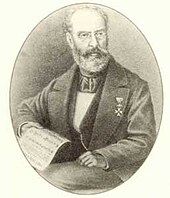
While much of present-day Greece was under Ottoman rule, the Ionian Islands enjoyed a Golden Age in music and opera. Corfu was the capital city of a Venetian protectorate and it benefited from a unique musical and theatrical heritage. Then in the 19th century, as aBritish Protectorate,Corfu developed a musical heritage of its own and which constitutes the nucleus of modern Greek musical history. Until the early 18th century, musical life took place in city and village squares, with performances of straight or musical comedies – known as Momaries or Bobaries. From 1720, Corfu became the possessor of the first theatre in post-1452 Greece. It was the Teatro San Giacomo (now the City Hall) named after the nearby Roman Catholic cathedral (completed in 1691).[155]
The island was also the center of theIonian School of music,the musical production of a group of Heptanesian composers, whose heyday was from the early 19th century till approximately the 1950s. It was the first school of classical music in Greece and it was a heavy influence for the later Greek music scene, after theindependence.
The three Philharmonics[edit]

Corfu's Philharmonic Societies provide free instruction in music, and continue to attract young recruits. There are nineteen such marching wind bands throughout the island.
Corfu city is home to the three most prestigious bands – in order of seniority:
- thePhilharmonic Society of Corfuuse dark blue uniforms with dark red accents, and blue and red helmet plumes. It is usually called theOld Philharmonicor simply thePaliá( "Old" ). Founded 12 September 1840.
- theMantzarosPhilharmonic Society use blue uniforms with blue and white helmet plumes. It is commonly called theNéa( "New" ). Founded 25 October 1890.
- theCapodistriaPhilharmonic Union use bright red and black uniforms and plumes. It is commonly called theCónte Capodístriaor simply theCónte( "Count"). It is the juniormost of the three (founded 18 April 1980).
All three maintain two major bands each, the main marching bands that can field up to 200 musicians on grand occasions, and the 60-strong studentbandinasmeant for lighter fare and on-the-job training.
The bands give regular summer weekend promenade concerts at the Spianada Green"pálko",and have a prominent part in the yearly Holy Week ceremonies.
Ionian University music department[edit]

Since the early 1990s a music department has been established at theIonian University.Aside from its academic activities, concerts in Corfu and abroad, and musicological research in the field of Neo-Hellenic Music, the Department organizes an international music academy every summer, which gathers together both international students and professors specialising inbrass,strings,singing,jazzandmusicology.
Theatres and operatic tradition[edit]
Teatro di San Giacomo[edit]

UnderVenetian rule,the Corfiotes developed a fervent appreciation of Italian opera, which was the real source of the extraordinary (given conditions in the mainland ofGreece) musical development of the island during this era.[156]The opera house of Corfu during the 18th and 19th centuries was theNobile Teatro di San Giacomo,named after the neighbouring Catholic cathedral; it was later converted into the City Hall.[156]It was both the first theatre and firstopera houseof Greece in modern times and the place where the first Greek opera (based on an exclusively Greeklibretto),Spyridon Xyndas'The Parliamentary Candidatewas performed.[156]A long series of local composers, such asNikolaos Mantzaros,Spyridon Xyndas,Antonio Liberali,Domenico Padovani,theZakynthianPavlos Carrer,theLambeletfamily,Spyridon Samaras,and others, all developed careers intertwined with the theatre.[156]San Giacomo's place was taken by the Municipal Theatre in 1902, which maintained the operatic tradition vividly until its destruction duringGerman air raidin 1943.[156]
The first opera to be performed in the San Giacomo was in 1733 ( "Gerone,tirannodiSiracusa"),[156]and for almost two hundred years, between 1771 and 1943, nearly every major opera from theItaliantradition, as well as many others from Greek and French composers, were performed on the stage of the San Giacomo; this tradition continues to be reflected in Corfiote operatic history, a fixture in famous opera singers' itineraries.[157]
Municipal Theatre of Corfu[edit]
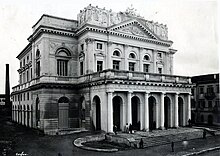
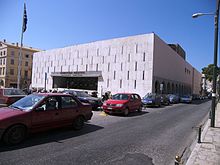
TheMunicipal Theatre of Corfu(Greek:Δημοτικό Θέατρο Κέρκυρας) was the main theatre andopera housein Corfu.[158]Opened in 1902, the theatre was the successor ofNobile Teatro di San Giacomo di Corfùwhich became the Corfu city hall. It was destroyed during aLuftwaffeaerial bombardment in 1943.[158]
During its 41-year history, it was one of the premier theatres and opera houses in Greece, and as the first theatre in Southeastern Europe,[158]it contributed to the arts and to the history of theBalkansand of Europe.[159][158][160]The archives of the theatre, including the historical San Giacomo archives, all valuables and art were destroyed in the Luftwaffe bombing with the sole exception of the stage curtain, which was not in the premises the night of the bombing and thus escaped harm; among the losses are believed to have been numerous manuscripts of the work ofSpyridon Xyndas,composer of the first opera in Greek.[158]
Festivities[edit]
Easter[edit]
OnGood Friday,from the early afternoon onward, the bands of the three Philharmonic Societies, separated into squads, accompany theEpitaph processionsof the city churches. Late in the afternoon, the squads come together to form one band in order to accompany theEpitaph processionof the cathedral, while the funeral marches that the bands play differ depending on the band; the Old Philharmonic playAlbinoni'sAdagio,the Mantzaros playVerdi'sMarcia FunebrefromDon Carlo,and the Capodistria playChopin'sFuneral MarchandMariani'sSventura.[161]
On Holy Saturday morning, the three city bands again take part in theEpitaph processionsof St. Spyridon Cathedral in procession with the Saint's relics.[161]At this point the bands play different funeral marches, with the Mantzaros playingMiccheli'sCalde Lacrime,the Palia playingMarcia FunebrefromFaccio'sAmleto,and the Capodistria playing theFuneral MarchfromBeethoven'sEroica.This custom dates from the 19th century, when colonial administrators banned the participation of the British garrison band in the traditional Holy Friday funeral cortege. The defiant Corfiotes held the litany the following morning, and paraded the relics of St. Spyridon too, so that the administrators would not dare intervene.
The litany is followed, at exactly 11:00 AM, the celebration of the "Early Resurrection"; balconies in the old city are decked in bright red cloth, and Corfiotes throw down large clay pots (thebótides,μπότηδες) full of water to smash on the street pavement, especially in wider areas ofListonand in an organised fashion.[161]This is enacted in anticipation of the Resurrection of Jesus, which is to be celebrated that same night,[161]and to commemorateKing David's phrase: "Thou shalt dash them in pieces like a potter's vessel" (Psalm 2:9).
Once thebótidescommotion is over, the three bands parade the clay-strewn streets playing the famous "Graikoí"festive march.[162]The march, which functions as the anthem of the island, was composed during the period of Venetian rule, and its lyrics include: "Greeks, never fear, we are all enslaved: you to the Turks, we to the Venetians, but one day we shall all be free".[citation needed]
[edit]
Another venerable Corfu tradition is known as theCarnivalorTa Karnavalia.Venetian in origin, festivities include a parade featuring the main attraction ofKarnavalos,a rathergrotesquefigure with a large head and smiling face, leading a diverse procession of colourfulfloats.[163]Corfiots, young and old, dress up in colourful costumes and follow the parade, spilling out into the area's narrow streets (kantounia) and spreading the festivities across the city,[163]dancing and socialising. At night, dance and costume parties are traditional.[163]
Cultural depictions[edit]
In myth[edit]
- It is in Corfu thatHeracles,just before embarking on his ten labours, slept with thenaiadMelite;their son was Hyllus (not to be confused withHyllus,the leader of theHeraclids,also a son of Heracles).[164]
- Corfu marks theArgonauts' refuge from the avengingColchicfleet, after their seizure of theGolden Fleece.[71]
- In the mythical sea adventure ofHomer'sOdyssey,Kerkyra is the island of thePhaeacians,(Phaiakes) whereinOdysseus(Ulysses) meetsNausica,the daughter of KingAlkinoos.The bay ofPalaiokastritsais considered to be the place where Odysseus disembarked.[165]
In literature[edit]
- British naturalistGerald Durrellwrote three books about his 1935–1940 childhood on Corfu:My Family and Other Animals;Birds, Beasts and Relatives;andThe Garden of the Gods.His brother, literary authorLawrence Durrell,also wrote a volume about Corfu:Prospero's Cell: A Guide to the Landscape and Manners of the Island of Corcyra (Corfu).
- Mary Stewart's novelThis Rough Magicis set in Corfu.
- Prospero's island inShakespeare's final play,The Tempest,is often said to have been based on Corfu.
- Letitia Landontwice wrote of Corfu as an island paradise, the first poetical illustration appeared in Fisher's Drawing Room Scrap Book, 1835, to a picture byThomas Allom[166]and the second in that for 1838, to a picture byCharles Bentley.[167](Corfu and Manduchio form Mount Olivet). A third poetical illustration of hers
 Strada Reale.—Corfu., to an engraving of a painting bySamuel Proutwas published in the Scrap Book for 1837.[168]
Strada Reale.—Corfu., to an engraving of a painting bySamuel Proutwas published in the Scrap Book for 1837.[168] - Humbert Humbert's first love,Annabel Leigh,is said to have died of typhus in Corfu in a scene ofVladimir Nabokov'sLolita.
- Albert Cohenwrote three books which are partially or entirely set in Corfu. They are:Mangeclous,Les Valeureux,andBelle du Seigneur.Cohen himself was born on the island.
- Voltairereferences two monks from Corfu in Chapter XXVIII ofCandide
In film[edit]
- Corfu was one of the main locations featured in the 1970 filmThe ExecutionerstarringGeorge PeppardandJoan Collins.[169]
- Corfu was one of the settings ofThe Burglars,a 1971 film starringJean-Paul BelmondoandOmar Sharif.
- The Countess of Corfu(Greek:Η Κόμησσα Της Κέρκυρας), a 1972 film starringRena VlahopoulouandAlekos Alexandrakis,was filmed in Corfu.
- Much of the 1978Billy WilderfilmFedorais set in Corfu and filmed on location.
- Some scenes of the 1978 filmThe Greek TycoonstarringAnthony QuinnandJacqueline Bissetwere filmed in Corfu.[170][171]The film is a fictionalized account of the life of the Greek shipping magnate,Aristotle Onassis.
- The 1980 French comedyJupiter's ThighstarringAnnie GirardotandPhilippe Noiretincludes some scenes inCorfu Town.[172]
- The 1981 James Bond movieFor Your Eyes Onlyhas a number of scenes filmed in Corfu. The most memorable scene of the film to be bound with the island is of the underwater ancient Greek temple, with a huge turtle swimming in front of the camera; a casino scene was also filmed at theAchilleion.[173]Other scenes filmed here include those tracing 'Melina' and James' walk through the city's streets, and Melina being greeted by Bond at Pontikonisi island. A major action element was filmed on the largest sandy beach on the island, Issos Beach in Agios Georgios South, involving a beach buggy chase along the dunes. The film's scene depicting a Greek wedding was filmed at the Bouas-Danilia traditional village (Μπούας Δανίλια παραδοσιακό χωριό).[173]Action scenes were also filmed at Neo Frourio.[174]
- The 1984 Greek film "Η Τιμή της Αγάπης" (The Price of Love), directed byTonia Marketakiis a tragic love story taking place in Corfu. It is based on the novelHonour and Moneyby Konstantinos Theotokis.[175]
- Corfu is also the setting of a 1987BBCTV series version, and a 2005 BBC movie version, ofMy Family and Other Animals,Gerald Durrell's book about his childhood in Corfu in the late 1930s
- The Gaze of the Gorgon(1992): a poem-film forBBCtelevision by British poetTony Harrison.The film examines the politics of conflict in the 20th century using the Gorgon as a metaphor. The imaginary narration of the film is done through the mouth of German-Jewish poetHeinrich Heine.The film describes the connection between the Corfu Gorgon at theArtemis Temple of CorfuandKaiser Wilhelm II.[176][177]Harrison concludes his 1992 film-poem by making a proposal that in the1994 European Union summit in Corfu,Heine's statue be returned to Corfu on time to preside over the new Europe so that EU can keep its eyes open and not turn to stone from the Gorgon's gaze.[177][178][179]
- ITVaired a TV series namedThe Durrells in Corfuin April 2016 and ultimately lasting four seasons, concluding in May 2019. It was a biographical series detailingGerald Durrell's childhood on Corfu.
In popular culture[edit]
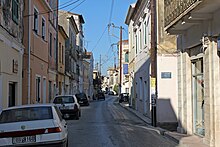
Corfu is one of the locations in the legend of Simon and Milo, where Simon falls in love temporarily. It is the setting of the 1998 song "Mediterranean Lady" byProzzak.The island is alluded to several times inDavid Foster Wallace's 1987 novel,The Broom of the System.Drakementions Corfu in a song. It is also mentioned in Brian Jacques' adventure novel, Voyage of Slaves.
Tourism[edit]

Corfiotes have a long history of hospitality to foreign residents and visitors, typified in the 20th century byGerald Durrell's childhood reminiscenceMy Family and Other Animals.The north east coast has largely been developed by a few British holiday companies, with large expensive holiday villas.[180]Package holidayresorts exist on the north, east and southwest coasts. Since 2021 there is an extra service added for visitors of the island calledThe Corfu Island Pass©.This official discount pass of Corfu gives everyone visiting Corfu a discount on sightseeing tours, rentals and cruises.
At the other end of the island, the southern resort ofKavosalso provides tourist facilities.
St George South to the west boasts the largest sandy beach on the island coupled with a selection of all-inclusive package hotels and traditional corfiot villas and flats. The Korission lake nature reserve also provides a stopover for European birds migrating south.
Up until the early 20th century, it was mainly visited by the European royals and elites, including EmperorWilhelm II of GermanyandEmpress Elisabeth of Austria;today it is also widely visited by middle class families (primarily from the UK,Scandinaviaand Germany). With the advent of the jet airliner bringing these groups relatively affordable 'package holidays', Corfu was one of the primary destinations for this new form of mass tourism.[181]It is still popular with the ultra-wealthy however, and in the island's northeast the homeowners include members of theRothschild familyand Russian oligarchs.[182][183]
Transport[edit]


The island is linked by two highways: GR-24 in the northwest and GR-25 in the south.
- Greek National Road 24, Cen., NW, Corfu – Palaiokastritsa
- Greek National Road 25, Cen., S, SE, Corfu – Lefkimi
Corfu has ferry services both by traditional ferries to Gaios in the island ofPaxoiand as far asPatrasand both traditional ferries and advanced retractableairfoil,hydrodynamic-flow, high-speed ferries called "Flying Dolphins" toIgoumenitsaandSarandëin neighbouringAlbania.The small port of Lefkimmi is also to be found at the southernmost tip of the island on Cape Kavos, offering aferryservice to the mainland.
TheIoannis Kapodistrias International Airport,named afterIoannis Kapodistrias,a Corfiot and European diplomat, and the first governor of the independent Greek state, is located around three kilometres south of Kerkyra, just half a kilometre north of Pontikonisi. The approach and landing, in a northeasterly direction, afford passengers aerial views ofPontikonisiand Vlaheraina Monastery, also taking in the hills ofKanoni,as the runway employed for landing lies a few hundred metres from these local landmarks. The airport offers domestic flights fromOlympic Airlines(OA 600, 602 and 606), andAegean Airlines(A3 402, 404 and 406). Seaplanes, Air Sea Lines, a Greek seaplane operator, offers scheduled flights from Corfu to Paxoi, Lefkada, Ithaki, Kefalonia,Ioannina,Patras andBrindisiin Italy.
The buses to the main places on the island run about six times a day between the city and Glyfada, Sidari, Paleokastritsa, Roda and Acharavi, Lefkimmi, Lefkimmi and Piri. Other coaches drive up to twice a day to Athens and Thessaloniki. City buses run through the city to the Airport, Achilleion, Gouvia, Afra, Pelekas and some other places of interest.
TheDiapontia Islandsare accessible by boat with regular services from Corfu port and Agios Stefanos Avliotes and by ferry from Corfu city port.
Economy[edit]

Corfu is mostly planted with olive groves and vineyards and has been producing olive oil and wine since antiquity. The main wine grape varietals found in Corfu are the indigenous whiteKakotrýgēsand redPetrokóritho,theCefalonianwhiteRobóla,theAegeanMoscháto(whitemuscat), theAchaeanMavrodáphnēand others.[184]
Modern times have seen the introduction of specialist cultivation supported by the mild climate, like thekumquatandbergamot oranges,which are extensively used in makingspoon sweetsandliqueurs.Corfu also produces local animal products, such as Corfiotegraviéra(a variant ofgruyere) and "Corfu"cheese (a variant ofGrana); "Corfu butter" (Boútyro Kerkýras), an intensely flavored cooking and baking butter made ofewe's milk;and thenoúmboulosalamimade of pork and lard and flavored with orange peel, oregano, thyme and other aromatic herbs, which are also burned for smoking.
Local culinary specialties includesofrito(avealrump roast ofVenetianorigin),pastitsáda(bucatinipasta served with diced veal cooked in a tomato sauce),bourdétto(codcooked in apepperysauce),mándoles(caramelizedalmonds),pastéli(honeybars made withsesame,almondsorpistachios),mandoláto(a "pastéli" made of crushed almonds, sugar, honey andvanilla), andtzitzibíra,the localginger beer,a remnant of the British era. There are three breweries in Corfu and one bed layers factory.
The island has again become an importantport of calland has a considerable trade in olive oil.[15]In earlier times there was a great export ofcitron,which was cultivated here, including for ritual use in the Jewish community during theSukkotholiday.
International relations[edit]
Twin towns – sister cities[edit]
Partner cities[edit]
Notable people[edit]
Ancient[edit]
- Nausicaadaughter of King Alcinous
- Arsenius(10th century), saint
- Peithias,leader during the Peleponnesian War
- Philiscus,tragic poet, born in Corfu
- Ptolichus(5th century BC), sculptor
- Saint Philomena(AD 291–304), virgin and martyr
Modern[edit]

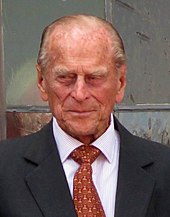
- H.R.H.Princess Alexia of Greece and Denmark,born in Corfu
- Marie Aspioti,M.B.E.,distinguished Corfiote magazine publisher and cultural figure who influenced the literary and cultural life of post-war Corfu
- Panos Aravantinos,artist, born in Corfu
- Felice Beato,19th-century photographer, born in Corfu
- Giacomo Casanova,lived on the island as an officer of the Venetian army
- Albert Cohen,Swiss-French author, born in Corfu
- Ian Hamilton,Military Officer, Led the 1915Gallipoli Landings,born in Corfu
- Haim Corfu,Israeli politician, was born in Jerusalem, his family name testifying to his family's origin
- Mathew Devaris,scholar, born in Corfu
- Tommaso Diplovataccio,Greco-Italian jurist, publisher and politician, born in Corfu
- Eleni Doika,Greek Olympic gymnast, born in Corfu
- Panagiotis Doxaras,painter, pioneer of theHeptanese Schoolof painting, worked and died in Corfu
- Gerald Durrelllived in Corfu and wrote autobiographic books about the topic of Corfu, includingMy Family And Other Animals,Birds, Beasts, and Relatives,andThe Garden of the Gods,making the island famous among the readers, books translated in many languages.
- Lawrence Durrellalso lived in Corfu for some years and Lawrence wrote, among several other books on Greece,Prospero's Cell: A Guide to the Landscape and Manners of the Island of Corcyra
- Elisabeth of Bavaria( "Sissi" ), Empress of Austria, built Achilleion as summer palace
- Kostas Georgakis,student, martyr of the resistance against theGreek military junta of 1967–1974,born in Corfu
- Angela Gerekou,actress, singer and politician, born in Corfu, wife ofTolis Voskopoulos
- Spyridon Gianniotis,Olympic silver medalist in swimming, raised in Corfu with father from Corfu
- Spyros Gogolos,footballer, born in Corfu
- Angelos Grammenos,actor
- Augustinos Kapodistrias,younger brother of Ioannis Kapodistrias, soldier and politician. He was born in Corfu.[187]
- Ioannis Kapodistrias,first Governor of Greece, born in Corfu
- Maria Desylla-Kapodistria,relative ofIoannis Kapodistrias,mayor ofCorfuand first female mayor of Greece[93]
- Kore. Ydro.,musical group, formed and based in Corfu
- Spyridon Lambros,history professor and formerPrime Minister of Greece,born in Corfu
- Petros Lantzas,rebel, spy and privateer
- Vicky Leandros,international pop star, born in Corfu
- Andreas Mandelis,expert onphotonics,member of theCanadian Academy of Engineering.Awarded the 2014Killam Prize
- Nikolaos Mantzaros,composer, born in Corfu
- Aristedes Metallinos,sculptor
- Margarita Miniati(1821–1897), Greek scholar and writer, born in Corfu
- Andreas Moustoxydis,historian and philologist, born in Corfu
- Vangelis Petsalis,classical musician and composer, born in Corfu
- H.R.H.Prince Philip, Duke of Edinburgh(1921–2021), born Prince Philippos of Greece and Denmark, in Corfu
- Petros Brailas Armenis,philosopher, politician, diplomat and former owner of the predecessor of theAchilleionpalace, born in Corfu
- Yvette Manessis Corporon - Greek American journalist and author
- Iakovos Polylas,first published ofDionysios Solomos,born in Corfu
- Major-GeneralSir Henry Ponsonby(1825–1895),Private SecretarytoHer Britannic MajestyQueen Victoria,Empress of India
- Alfredo Ragona(born 1922), Greek footballer
- Georgios Rallis(1918–2006), prime minister, son of Ioannis Rallis and Zaira, daughter of George Theotoki
- Alexander Rossi,artist, born in Corfu
- Sakis Rouvas,singer and athlete, born in Corfu
- MarshalJohann MatthiasReichsgrafvon der Schulenburg,Austrian general and aristocrat. TheReichsgrafsuccessfully defended the island against the Ottoman Turks during the siege of 1716 as leader of the Venetian forces in Corfu
- Spyridon Samaras,composer, born in Corfu
- Edith Œnone Somerville(1858-1949), Irish novelist was born in Corfu
- Nikolaos Sophianos,humanist and cartographer, born in Corfu
- Carl Ludwig Sprenger,German botanist, lived in Corfu
- Theodore Stephanides,poet, author, doctor and naturalist, born in Corfu
- Georgios Theotokis,formerPrime Minister of Greece,born in Corfu
- Ioannis Theotokis,politician, born in Corfu
- Nikephoros Theotokis(1732–1800), Greek educator and Russian archbishop, born in Corfu
- Antonio Vivaldicomposer. In 1716, on commission by the republic of Venice, created theoratorioJuditha triumphansto commemorate victory over the Turks during the great siege of 1716.
- Rena Vlahopoulou,actress and singer, born in Corfu
- Eugenios Voulgaris,scholar, born in Corfu
- Gaetano Giuffrè,composer, Maestro, born in Corfu
- Sotirios Voulgaris(1857–1932), cosmetologist, founder of the Bulgari jewellery store that later became the famousBulgaricompany
- Spyridon Xyndas(1812–1896), composer and musician, born in Corfu
- KaiserWilhelm II of Germany,bought Achilleion after Sissi's death
- Markos Antonios Katsaitis(1717–1787), was an 18th-centuryGreekscholar, geographer and lawyer born in Corfu[188]
- Spiro Çomora,famous Albanian dramatist
- Anthony Stevens,Jungian analyst, lived in Corfu
Gallery[edit]
-
Cape Drastis at the northwest tip of Corfu island
-
Chalikiopoulou Lagoon (or Lake Chalikiopoulou), south of Corfu town
-
Old tower, Corfu town
-
Panorama of the Old Town of Corfu
-
Venetian quarter, Corfu town
-
Odós Ipeirouin Corfu old town
-
Historic building inEvgeniou Voulgareosstreet
-
View of St. George's Temple at theOld Fortress
-
Gardens ofAchilleion
-
Statues at theAchilleionterrace
-
Villa Rossa,landmark of Corfu city
-
Pelekasvillage
-
Kaiser's Bridge in Corfu c. 1918
-
Workers on Corfu. The image shows the Old Fortress. First World War
See also[edit]
- Aspioti-ELKA
- Cuisine of the Ionian islands
- Heptanese School (painting)
- Hercules (vehicles)
- Korčula
- Music of the Heptanese
- Temple of Hera, Mon Repos
Explanatory notes[edit]
- ^Ancient Greek:Κόρκυρα,romanized:Kórkyra,pronounced[kórkyra];Medieval Greek:Κορυφώ,romanized:Koryfó;Latin:Corcyra.
Citations[edit]
- ^abPacke, Cathy (22 November 2016)."The Complete Guide To: Corfu".The Independent.Archived fromthe originalon 27 April 2021.Retrieved27 August2021.
- ^Trevor Webster (1994).Where to Go in Greece: A New Look.Vol. 1. Settle Press. p. 221.ISBN9781872876207.
Corfu is one of the most northern isles in Greece and also the most westerly, apart from three of its own small satellite isles...
- ^abhttps://corfutvnews.gr/diaspasi-deite-tin-tropologia/(in Greek)
- ^"ΦΕΚ B 1292/2010, Kallikratis reform municipalities"(in Greek).Government Gazette.
- ^Thucydides,History of the Peloponnesian War1.36.3
- ^abcd"Corfu City Hall website".City of Corfu.Archived fromthe originalon 6 January 2008.
In literature, apart from the Homeric name Scheria, we meet various other names for the island, like Drepanë or Arpi, Makris, Cassopaea, Argos, Keravnia, Phaeacia, Corkyra or Kerkyra (in Doric), Gorgo or Gorgyra and much later the medieval names Corypho or Corfoi, because of the two characteristic rock-peaks of the Old Fortress of Corfu.
- ^abJohann Georg Keyssler(1760).Travels Through Germany, Bohemia, Hungary, Switzerland, Italy, and Lorrain: Giving a True and Just Description of the Present State of Those Countries….G. Keith. p. 54.Retrieved6 July2013.
Corfu is not only a bulwark to the Venetians against the attack of a foreign enemy,... [...]....and, since count Schulenburg caused several fortifications to be added to it, it may justly be looked upon as one of the strongest places in Europe.
- ^"on UNESCO World Heritage List".BBC News.28 June 2007.Retrieved29 June2009.
- ^"UNESCO Advisory Body ICOMOS report on Corfu History"(PDF).Retrieved3 July2007.
- ^"Old Town of Corfu on UNESCO website retrieved 3 July 2007".Whc.unesco.org.Retrieved29 June2009.
- ^ANDREW MARSHALL IN CORFU (24 June 1994)."European Union Summit: Corfu summiteers ready to fudge key EU decision".The Independent.
- ^Duncan Garwood, Mediterranean Europe, 2009
- ^Russell King, John Connell, Small worlds, global lives: islands and migration, 1999
- ^abc"Korkyra".Theoi.Greek Mythology Encyclopedia.Retrieved29 June2009.
- ^abcdefghijklmnopqrstOne or more of the preceding sentences incorporates text from a publication now in thepublic domain:Gardner, Ernest Arthur; Caspari, Maximillian Otto Bismark (1911). "Corfu".InChisholm, Hugh(ed.).Encyclopædia Britannica.Vol. 7 (11th ed.). Cambridge University Press. pp. 145–146.
- ^"Population & housing census 2001 (incl. area and average elevation)"(PDF)(in Greek). National Statistical Service of Greece. Archived fromthe original(PDF)on 21 September 2015.
- ^ab"Corfu honored with a new museum".Koine.terapad.Retrieved29 June2009.
- ^ab"Lazaretto Islet".Travel-to-Corfu.Retrieved29 June2009.
- ^"Corfu climate: Average Temperature, weather by month, Corfu water temperature - Climate-Data.org".en.climate-data.org.Retrieved21 March2023.
- ^"Kekira Climate extremes 1991-present".Retrieved1 March2023.
- ^"Mean Corfu Climatic Averages".Hellenic National Meteorological Service. Archived fromthe originalon 24 January 2015.Retrieved1 March2015.
- ^"Kekira Climate Normals 1961–1990".National Oceanic and Atmospheric Administration.Retrieved1 March2015.
- ^"Mean Corfu Climatic Averages".Hellenic National Meteorological Service. Archived fromthe originalon 24 January 2015.Retrieved1 March2015.
- ^Panitsa, M. & E. Iliadou 2013: FLORA AND PHYTOGEOGRAPHY OF THE IONIAN ISLANDS (Greece). 2nd Botanical Conference in Menorca.
- ^Gasteratos, I. unpublished data.
- ^Γαστεράτος Ι. 2020: Τα Πουλιά των Προστατευόμενων Περιοχών της Κέρκυρας. Διημερίδα 'Οι Προστατευόμενες Περιοχές του Φορέα Διαχείρισης Καλαμά – Αχέροντα – Κέρκυρας' 24-25/1/2020.
- ^Γαστεράτος, Ι. 2019: Αλλαγές σε οικοσυστήματα της Κέρκυρας. Κάποια παραδείγματα. Επιστημονικό – Εκπαιδευτικό Συνέδριο 'Βιοποικιλότητα – Κλιματική αλλαγή και επιπτώσεις της σε νησιωτικά οικοσυστήματα.' Κέρκυρα 6-8/3/2020.
- ^Frantzis, A. 2009: Cetaceans in Greece: Present status of knowledge. Initiative for the Conservation of Cetaceans in Greece.
- ^Ruiz-Olmo, J. 2006: The Otter (Lutra lutra L.) on Corfu Island (Greece): Situation in 2006. IUCN Otter Spec. Group Bull. 23: 17-25.
- ^abcdeStille, M., Gasteratos, I. & B. Stille 2021: Larger mammals of Corfu, Ionian Islands, Greece – status and potential threats. Russian Journal of Theriology 20(2): 204-214.
- ^Roberts, G. 2022: Otter survey of the island of Corfu 2021. OTTER, Journal of the International Otter Survival Fund 2022: 39-42.
- ^Masseti, M. (2010). "Homeless mammals from the Ionian and Aegean islands".Bonn Zoological Bulletin.57(2): 367–373.
- ^Gasteratos, I. & Z. Fondoulakou 2018:The presence and the extinction of the Golden JackalCanis aureusfrom the Island of Corfu, northwestern Greece.Conference: 2nd International Jackal Symposium: Marathon, Greece.
- ^Hanák, V., Benda, P., Ruedi, M., Horacek, I. & T.S. Sofianidou 2001: Bats (Mammalia: Chiroptera) of Eastern Mediterranean. Part 2. New records and review of distribution of bats in Greece. Acta Societatis Zoologicae Bohemicae 65: 279-346.
- ^Life GRECABAT: Κατάλογος σπηλαίων με εποχές παρουσίας σημαντικών αποικιών (accessed in: 28/4/2021).
- ^Stille, M., Gasteratos, I. & B. Stille 2021: Alien and invasive terrestrial vertebrate species on Corfu, Ionian Islands, Greece. Journal of Vertebrate Biology 70(1): 1-13.
- ^Stille, B. & M. Stille 2017: The Herpetofauna of Corfu and adjacent Islands.
- ^abc"About the Corfu Butterfly Conservation".Corfu Butterfly Conservation.Retrieved11 March2022.
- ^Danahar G. W. (2020) Corfiot Butterflies – a contemporary perspective and global context, European Butterflies, Issue 3, pages 6-7.
- ^Danahar G. W. (2022) Corfu Butterfly Conservation (CBC) – our first year of survey work - 2021, European Butterflies, Issue 5, pages 18 - 21.
- ^"Palaeolexicon, Word study tool of ancient languages".
- ^Strab. vi. p. 407
- ^W.H. Race,Apollonius Rhodius: Argonautica,Loeb Classical Library (2008), p. 409 n. 125–27; verses 4.982–992
- ^Cees H. Goekoop (15 September 2010).Where on Earth Is Ithaca?: A Quest for the Homeland of Odysseus.Eburon Uitgeverij B.V. p. 85.ISBN978-90-5972-344-3.Retrieved11 November2012.
- ^Wilkes 1996,pp. 100–101, 111.
- ^Šašel Kos 2005,pp. 183.
- ^Barnett 2016,pp. 72–73.
- ^Thucydides. "The Revolution in Corcyra." c. 400 BCE. Reprinted in Rogers, Perry.Aspects of Western Civilization.pp. 76–78. Pearson: Upper Saddle River. 2011.
- ^The Oxford Classical Dictionary,Oxford University Press, Oxford: 1992.
- ^Leontsini 2014,pp. 26–27.
- ^Leontsini 2014,pp. 28–29.
- ^Leontsini 2014,pp. 32–33.
- ^Leontsini 2014,pp. 30–31.
- ^Leontsini 2014,pp. 31–32, 33–34.
- ^abLeontsini 2014,p. 35.
- ^Leontsini 2014,p. 34.
- ^Leontsini 2014,pp. 36–38.
- ^Runciman, Steven (1958).The Sicilian Vespers.Cambridge: Cambridge University Press. p.43.ISBN978-1-107-60474-2.
- ^Hazard, H. W. (2017). A History of the Crusades, Volume 2: The Later Crusades, 1189-1311. USA: University of Pennsylvania Press, Incorporated, p. 260
- ^Keil, Charles; Keil, Angeliki; Feld, Steven (9 December 2002).Bright Balkan Morning: Romani Lives and the Power of Music in Greek Macedonia.Wesleyan University Press. p. 108.ISBN9780819564887.
- ^Fraser, Angus (23 February 1995).The Gypsies.Wiley. pp. 50–51.ISBN9780631196051.
- ^abThe Scots Magazine and Edinburgh Literary Miscellany.Vol. 71. Archibald Constable. 1809. p. 916.Retrieved6 July2013.
Under the Venetians, in the middle ages, and down even to the seventeenth century, Corfu was esteemed the advanced bastion and bulwark of the Christian states, against the Ottoman power, when the Solymans and the Sclims menaced...
- ^John Julius Norwich (4 December 2007).The Middle Sea: A History of the Mediterranean.Knopf Doubleday Publishing Group. p. 385.ISBN978-0-307-38772-1.Retrieved6 July2013.
For Venice only a single bulwark remained: Corfu. The army that, early in 1716, the Grand Vizir flung against the citadel of Corfu consisted of 30,000 infantry and some 3,000 horse.
- ^Elizabeth Mary Leveson-Gower Grosvenor Westminster (2d marchioness of) (1842).Narrative of a Yacht Voyage in the Mediterranean: During 1840–41.J. Murray. p. 250.Retrieved6 July2013.
Corfu thus became a strong bulwark against the Turks, whose frequent attacks were successfully repulsed. In 1716 it was besieged for forty-two days by a formidable Ottoman army and fleet, and several daring attempts were made to storm...
{{cite book}}:CS1 maint: numeric names: authors list (link) - ^Sir Richard Phillips (1822).New Voyages and Travels: Consisting of Originals, Translations, and Abridgments; with Index and Historical Preface.C. Wiley. p. 63.Retrieved6 July2013.
The town of Corfu, the bulwark of Italy and of the east, is Covered in all directions, towards the sea and land,
- ^John Knox (1767).A New Collection of Voyages, Discoveries and Travels: Containing Whatever is Worthy of Notice, in Europe, Asia, Africa and America.J. Knox. p. 203.Retrieved6 July2013.
Some pieces by Castiglione, deserved particular notice, together with the last siege, and the new fortifications of Corfu, which is not only painted on a picture, but curiously modelled in wood. Corfu is not only a bulwark to the Venetians, against...
- ^Kenneth Meyer Setton (1991).Venice, Austria, and the Turks in the Seventeenth Century.American Philosophical Society. p.253.ISBN978-0-87169-192-7.Retrieved6 July2013.
Thus the important stronghold of Corfu was protected (according to a dispatch of Antonio Priuli, proveditor generale da... Morea would prove to be, for they were bulwarks against the Turks' intrusion into the Adriatic.17 Corfu was apparently...
- ^Henry Jervis-White-Jervis(1852).History of the island of Corfú and of the republic of the Ionian Islands.Colburn and co. p.126.Retrieved6 July2013.
...sister of Sixtus-Quintus, to the Book of Gold, the Holy Father having expressed his gratitude, the Venetians represented to him that the protection of Corfu and Candia, which were the two bulwarks of Christianity, cost them more than 500,000...
- ^"The Gulf of Venice runs for 800 mi (1,287 kilometres) between Italy and Esclavonia, and at the end of it is the island of Corfu, which the Venetians call their door, although Venice is in fact 800 mi (1,287 kilometres) away." (Pedro Tafurin 1436,Andanças e viajes).
- ^Will Durant.The Renaissance.page 684. MJF Books. New York, 1981ISBN1-56731-016-8
- ^abcdefghij"History of Corfu".Corfuweb.gr. Archived fromthe originalon 11 April 2009.Retrieved29 June2009.
- ^"History of Corfu from xenos website".Archived fromthe originalon 14 August 2007.
- ^The Cambridge Illustrated Atlas of Warfare: Renaissance to Revolution, 1492–1792.Cambridge University Press. 1996. p. 25.ISBN978-0-521-47033-9.Retrieved6 July2013.
The Ottomans were a major and expanding presence in Europe, Asia, and Africa.... The knights, their fortifications strengthened by bastions, resisted assaults and bombardment before accepting... Ottoman naval pressure on Europe increased in the Mediterranean, with sieges of Corfu in 1537 (map 2) and Reggio in 1543.
- ^ca:Història de Corfú
- ^https://jguideeurope.org/fr/region/grece/corfou/
- ^https:// jewishvirtuallibrary.org/corfu
- ^https:// researchgate.net/publication/233155172_The_Port_Jews_of_Corfu_and_the_%27Blood_Libel%27_of_1891_A_Tale_of_Many_Centuries_and_of_One_Event
- ^https://api.parliament.uk/historic-hansard/commons/1891/may/15/anti-jewish-riots-at-corfu
- ^https:// jewishencyclopedia /articles/4656-corfu
- ^ "Serbs in Corfu website".Archived fromthe originalon 28 September 2007.
- ^abcdefHistory of Corfu from Corfu City Hall websiteArchived6 January 2008 at theWayback Machine
- ^abUnited States Holocaust Memorial MuseumArchived12 March 2007 at theWayback Machineon the Holocaust in Corfu. Also contains information about the Nazi collaborator mayor Kollas.
- ^From the interview ofa survivorin the film "Shoah"
- ^ab"Central Jewish Council of Greece website".Kis.gr. Archived fromthe originalon 17 October 2007.Retrieved29 June2009.
- ^United States Holocaust Memorial MuseumArchived8 December 2012 at theWayback Machine:"[...]two hundred of the 2,000 Corfu Jews found sanctuary with Christian families[...]"
- ^BBC WW2 People's WarQuote: "By the time I got back to camp the troop had returned from Corfu full of stories about the wonderful reception they’d had from the locals as the liberators of the island." Bill Sanderson's Wartime Experiences -Part 4 – 40 Commando by Bill Sanderson (junior) Bill Sanderson's Wartime Experiences -Part 4 – 40 Commando by Bill Sanderson (junior) Retrieved 31 July 2008
- ^abWright, Quincy (1949)."The Corfu Channel Case".The American Journal of International Law.43(3): 491–494.doi:10.2307/2193642.JSTOR2193642.S2CID147423999.
- ^Corfu Channel IncidentRecords of the Admiralty, Naval Forces, Royal Marines, Coastguard, and related bodies U.K. Retrieved 31 July 2008.
- ^Bancroft, Harding F.; Stein, Eric (1949). "The Corfu Channel Case: Judgment on the Preliminary Objection".Stanford Law Review.1(4): 646–657.doi:10.2307/1226351.JSTOR1226351.
- ^Cook, Bernard A. (2001).Europe Since 1945: An Encyclopedia.Taylor & Francis.ISBN9780815340577.
- ^"World Court Gets Albanian Dispute".The New York Times.10 April 1947. pp. 1, 10.
- ^Anderson, David (10 April 1949). "World Court Finds Albania Liable in Corfu Mining of 2 British Ships".The New York Times.pp. 1, 15.
- ^abMunicipality of Corfu from the Internet archiveQuote: "In the elections of 1954 Stamatios Desillas was elected Mayor for a second term and remained in office until his death, Christmas Day 1955. Soon after a bye-election took place in Corfu in which the widow of the deceased Maria Desilla – Kapodistria, was elected Mayor with 5,365 votes in a total of 10,207. Maria Desilla became Mayor of Corfu on 15 April 1956 until 9 May 1959. She was the first female Mayor in Greece."
- ^"Corfu General Hospital".Archived fromthe originalon 25 December 2007.
- ^"Corfu Radio Station History".Tvradio.ert.gr. Archived fromthe originalon 2 April 2009.Retrieved29 June2009.
- ^Alfa HistoryArchived23 July 2011 at theWayback MachineQuote:1995 The first in Corfu ISP by Alfa and Forthnet.
- ^R. Winkes (editor), Kerkyra. Artifacts from the Palaiopolis, Providence 2004.
- ^abJohn C. G. Röhl (1998).Young Wilhelm: The Kaiser's Early Life, 1859–1888.Cambridge University Press. p.297.ISBN978-0-521-49752-7.Retrieved4 May2013.
After the purchase of the 'Achilleion', Kekule was invited by the Kaiser to go to Corfu to provide advice on the positioning of the... 94 Without a doubt, Wilhelm's lifelong obsession with the statue of the Gorgon unearthed in Corfu stems from the...
- ^Sherry Marker; John S. Bowman; Peter Kerasiotis (1 March 2010).Frommer's Greek Islands.John Wiley & Sons. p. 476.ISBN978-0-470-52664-4.Retrieved4 May2013.
Achilles that the Kaiser had inscribed, to the Greatest Greek from the Greatest German, a sentiment removed after World War II.
- ^Frank Giles; Spiro Flamburiari; Fritz Von der Schulenburg (1 September 1994).Corfu: the garden isle.J. Murray in association with the Hellenic Group of Companies Ltd. p. 109.ISBN978-1-55859-845-4.Retrieved4 May2013.
Although subsequently demolished in 1944 to allow the passage of a huge German coastal gun beneath, the locality still bears the name "Kaiser's Bridge".
- ^Corfu mapArchived12 October 2007 at theWayback Machine:The bridge was destroyed during a German attack in World War II. The remains can still be seen today.
- ^Corfu Life UKArchived4 October 2008 at theWayback MachineQuote: "The French were the ones who turned the Spianada into a public square and park – one of the biggest in Europe"
- ^Brohure of KerkyraArchived3 October 2008 at theWayback MachineQuote: "SOCCER The tournament will start on Wednesday 04 of July An Open Ceremony and a parade of all the teams will take place in the biggest square in the Balkansand one of the most impressive ones in the whole continent, to the square Spianada itself which is constructed similarlyto the Royal Gardens of Europe."
- ^Nondas Stamatopoulos (1993).Old Corfu: history and culture.N. Stamatopoulos. p. 172.ISBN9789608403000.
The Palace of St. Michael and St. George (Plate III), which is generally considered the finest of the British buildings in... seat of the Order of St. Michael and St. George which had been instituted in 1818 to honour distinguished British and local...
- ^A. F. Madden (1985).Select Documents on the Constitutional History of the British Empire and Commonwealth: "The Empire of the Bretaignes," 1175–1688.Greenwood Publishing Group. pp. 690–.ISBN978-0-313-23897-0.
- ^abcdefgSapirstein, Philip (1 January 2012). "The Monumental Archaic Roof of the Temple of Hera at Mon Repos, Corfu".Hesperia.81(1): 31–91.doi:10.2972/hesperia.81.1.0031.JSTOR10.2972/hesperia.81.1.0031.S2CID193469029.
- ^abcFranklin P. Johnson (January 1936). "The Kardaki Temple".American Journal of Archaeology.40(1): 46–54.doi:10.2307/498298.JSTOR498298.S2CID191378100.
This is the only Greek Doric building that is known to have had no frieze.
(subscription required) - ^William Bell Dinsmoor; William James Anderson (1973).The Architecture of Ancient Greece: An Account of Its Historic Development.Biblo & Tannen Publishers. p. 92.ISBN978-0-8196-0283-1.
- ^Acta Ad Archaeologiam Et Artium Historiam Pertinentia: 4o."L'Erma" di Bretschneider. 1978. p. 47.
In this respect it is surpassed only by the perhaps slightly later temple at Kardaki on Corfu (*), where the frieze was completely omitted. This is nothing but the logical consequence of the tendencies from the early Sicilian temples, where the ties...
- ^Robertson, D. S.(May 1969).Greek and Roman Architecture(2 ed.). Cambridge University Press. p.326.ISBN978-0-521-09452-8.
- ^Campbell, Gordon (2007).The Grove Encyclopedia of Classical Art and Architecture.Oxford University Press. p. 311.ISBN978-0-19-530082-6.
A second temple, at Kardaki on the east side of Corfu town, was also Doric but had 6 by 12 columns, and its cella had neither false porch nor adyton. The columns are widely spaced, and the unusual absence of a triglyph and metope frieze may be explained by the influence of Ionic forms.
- ^abcDarling 2004,pp.184–186.
- ^abCruickshank 2000,Chapter One: "Temple of Artemis, Corcyra", p.18:"The island of Corfu, to the northwest of present-day Greece, off the coast of Albania, was an early colony of the city of Corinth and was under Corinthian control when its Temple of Artemis was constructed. A milestone in Greek architecture, this was the first building that was truly Doric. Many if not all of its Doric characteristics had appeared in earlier structures but here they were used for the first time as an ensemble."
- ^Gates 2003,pp.211–213.
- ^Raaflaub & van Wees 2009,Chapter 10: Sanne Houby-Nielsen, "Attica: A View from the Sea", p.203.
- ^Margaret M. Miles (8 August 2016).A Companion to Greek Architecture.John Wiley & Sons. p. 169.ISBN978-1-4443-3599-6.
- ^Marconi, Clemente (5 February 2007).Temple Decoration and Cultural Identity in the Archaic Greek World: The Metopes of Selinus.Cambridge University Press. p. 219.ISBN978-0-521-85797-0.
- ^"Philip Sapirstein:" el templo de Hera fue construido originalmente con la columnata de piedra "".mediterraneoantiguo.16 September 2016.
- ^abGardner, Percy(1896).Sculptured Tombs of Hellas.London: Macmillan and Company, Limited. p.200.
- ^Luca Di Lorenzo (9 May 2018).Corfù - La guida di isole-greche.Luca Di Lorenzo. p. 205.ISBN978-88-283-2151-4.Archived fromthe originalon 26 June 2019.
- ^abcd"Funerary Archaic Lion".Archaeological Museum of Corfu.Archived fromthe originalon 14 May 2019.Retrieved14 May2019.
- ^Nick Fisher; Hans van Wees (31 December 1998).Archaic Greece: New Approaches and New Evidence.Classical Press of Wales. p. 41.ISBN978-1-910589-58-8.
- ^Germain Bazin (1976).The History of World Sculpture.Chartwell Books. p. 127.ISBN9780890090893.
This lion was found near the tomb of Menekrates in the necropolis of ancient Kerkyra (modern Corfu). Menekrates was a Lokrian, the proxenos of the people of Kerkyra, according to a metric inscription on the grave monument.
- ^"Το μνημείο του Μενεκράτη".Odysseus.Archived fromthe originalon 5 November 2019.Retrieved14 May2019.
- ^"St. George Article".Archived fromthe originalon 11 March 2007.
- ^Nondas Stamatopoulos (1993).Old Corfu: history and culture.N. Stamatopoulos. p. 162.ISBN9789608403000.
The New Fortress was built on the hill of St. Mark between 1572 and 1645, the military engineer...
- ^abStamatopoulos, Nondas (1993).Old Corfu: history and culture(3 ed.). N. Stamatopoulos.ISBN9789608403000.
On a precipitous rocky peak dominating a wide range of coastline around Palaeokastritsa stand the crumbling walls and battlements of the twelfth-century Byzantine Fortress of Angelokastro, not far from the village of Krini. (p. 163) [...] After a siege lasting a year the invaders were finally driven away by the defenders of the fortress who were helped by the inhabitants of the neighbouring villages. Again, during the first great siege of Corfu by the Turks in 1537, Angelocastro successfully resisted attack. About 3,000 villagers had sought refuge within the fortress to escape the fate of the inhabitants of other parts of the island who were... In 1571, when they once more invaded Corfu, the Ottomans again unsuccessfully attacked, Angelocastro, where 4,000 people had taken refuge. During the second great siege of the city by the Ottomans in 1716, Angelokastro once again served as a refuge for the...During the course of the centuries Angelocastro played an important part in the defence of the island. In 1403 a force of Genoese soldiers, under the command of the French condottiere Boucicaut, landed at Palaeokastritsa and attacked... The fortress existed in 1272 when it was formally taken over by the Italian Giordano di San Felice in the name of the Angevin rulers of Naples, who held the island of Corfu from 1267 to 1386. (p. 164)[...]...Angelocastro was probably built during the reign of the Byzantine Emperor Manuel Comnenos (1143 - 1 180).(p. 164)[...]This was used as a hermitage and was converted into a chapel, probably around the end of the eighteenth century (p. 165)[...]From the top of Angelocastro the view sweeps far and wide over the hills across the breadth of Corfu, to the town, the Eastern Channel and the mountains on the mainland, over a sheer drop of a thousand feet to the sea below (p.325)
- ^Michaēl S. Kordōsēs (1981).Symvolē stēn historia kai topographia tēs periochēs Korinthou stous mesous chronous.Vivliopōleio D.N. Karavia. p. 140.Retrieved19 September2013.
Ή ύπαρξη βυζαντινών έρειπίων στή θέση Πατίμα δείχνει πιθανότατα ότι στό σημείο αύτό ύπήρχε βυζαντινός οικισμός. Δέν άποκλείεται, σέ δυσκολότερα χρόνια, ό πληθυσμός νά μετοίκησε άπό τή θέση αύτήστσν οχυρωμένο λόφο. Εκτός άπό τό βυζαντινό φρούριο, στήν περιοχή τοϋ Άγγελοκάστρου παρουσιάζουν ένδιαφέρον καί δυό παλιές έκ- κλησίες, πού...Ο Buchon, που επισκέφθηκε το καστρο, υποθέτει οτι χτιστηκε ατα τελη του ΙΒ' αιώνα από καποιο μελος της οικογενειας των Αγγελων Κομνηνων, σε μια ταραγμένη εποχή που ευνοουσε προσωπα με κυρος να γινονται ανεξαρτητα απο το κεντρο. Τα τειχη του, γραφει, μαρτυρουν βιαστικη κατασκευή.
- ^John S. Bowman; Peter Kerasiotis; Sherry Marker (10 January 2012).Frommer's Greece.John Wiley & Sons. p. 567.ISBN978-1-118-20577-8.Retrieved11 February2013.
- ^Nondas Stamatopoulos (1993).Old Corfu: history and culture.N. Stamatopoulos. pp. 164–165.ISBN9789608403000.Retrieved6 April2013.
Again, during the first great siege of Corfu by the Turks in 1537, Angelocastro... and After a siege lasting a year the invaders were finally driven away by the defenders of the fortress who were helped by the inhabitants of the neighbouring villages. In 1571, when they once more invaded Corfu, the Turks again unsuccessfully attacked, Angelocastro, where 4,000 people had taken refuge. During the second great siege of the city by the Turks in 1716, Angelokastro once again served...
- ^DK Publishing (1 May 2012).Top 10 Corfu & the Ionian Islands.DK Publishing. p. 80.ISBN978-0-7566-9434-0.
- ^abNick Edwards (2003).The Rough Guide to Corfu.Rough Guides. p.223.ISBN978-1-84353-038-1.
On the other side of Mount Ayios Matheos. 2 km by road, is Gardiki Pirgos, the ruins of a thirteenth century castle built in this unlikely lowland setting by the despots of Epirus.
- ^abDēmētrēs Philippidēs (1983).Greek Traditional Architecture: Eastern Aegean, Sporades-Ionian Islands.Vol. 1. Melissa. p. 222.
- ^ab"The Old Town of Corfu Nomination for inclusion on the World Heritage List STATE PARTY Greece STATE, PROVINCE OR REGION Greece, lonian Islands Region, Corfu Prefecture NAME OF PROPERTY The Old Town of Corfu"(PDF).UNESCO.p. 29.
One thing is certain, however. The area under plough outside the walls increased, since the village communities multiplied across the entire island (if we are to judge from the Byzantine castles that have survived) in order to protect the fields. They are castles such as Kassiopi, Angelokastro and Gardiki and, of course, the Old Fortress which was the medieval town itself.
- ^abStamatopoulos, Nondas (1993).Old Corfu: history and culture(3 ed.). N. Stamatopoulos. p. 166.ISBN9789608403000.
- ^abMartin Young (1977).Corfu and the Other Ionian Islands.Cape. p. 108.ISBN978-0-224-01307-9.
- ^Sotiris Voyadjis; Ασπασία Ραπτάκη (January 2007).Το κάστρο της Κασσιώπης, Κέρκυρα.Περί Ιστορίας, Τ. 5, 2007(in Greek).Academia.edu,Ionian Society of Historical Studies: 13–34.
- ^Συνολική Ανάδειξη Κάστρου Κασσιώπης(PDF)(in Greek). 21st Ephorate of Byzantine Antiquities of Greece. p. 384. Archived fromthe original(PDF)on 4 March 2016.Retrieved8 May2019.
- ^"Τροποποίηση του άρθρου 1 του ν. 3852/2010"[Amendment of Article 1 of l. 3852/2010] (in Greek).Government Gazette.p. 1164.
- ^The Literary Panorama, and National Register.Cox, Son, and Baylis. 1811. p. 561.
- ^abE. Nikolaidēs (15 December 2011).Science and Eastern Orthodoxy: From the Greek Fathers to the Age of Globalization.JHU Press. p. 171.ISBN978-1-4214-0298-7.
- ^Sir John Edwin Sandys (1967).A History of Classical Scholarship: The eighteenth century in Germany, and the nineteenth century in Europe and the United States of America.Hafner Pub. Co. p. 369.
- ^"History of the University".
- ^"Ionian University Brochure 2017".ionio.gr.
- ^"Ionian University Summer Schools".ionio.gr.
- ^"Libraries and Museums from the City Hall website".Archived fromthe originalon 6 January 2008.
- ^Frommer's Review."Archaeological Museum".The New York Times.Archived fromthe originalon 11 August 2011.Retrieved26 September2011.
- ^Eleni BistikaKathimeriniArticle on Ioannis Kapodistrias 22 February 2008 Quote:Η γενέτειρά του Κέρκυρα, ψύχραιμη, απολαμβάνει το προνόμιο να έχει το γοητευτικό Μουσείο Καποδίστρια στη θέση Κουκουρίσα,Translation:His birthplace, Corfu, cool, enjoys the privilege to have the charming Museum Kapodistria in the location Koukourisaandεξοχική κατοικία με τον μαγευτικό κήπο της οικογενείας Καποδίστρια, που η Μαρία Δεσύλλα – Καποδίστρια δώρισε στις τρεις κερκυραϊκές εταιρείεςTranslation:summer residence with the enchanting garden of the Kapodistrias family, which Maria Dessyla Kapodistria donated to the three Corfiote societies
- ^Robert Holland (26 January 2012).Blue-Water Empire: The British in the Mediterranean since 1800.Penguin Books Limited. p. 506.ISBN978-1-84614-555-1.
- ^John Freely (30 April 2008).The Ionian Islands: Corfu, Cephalonia and Beyond.I.B.Tauris. p. 44.ISBN978-0-85771-828-0.
- ^Essential Corfu.AA Publishing. 1995. p. 11.ISBN978-0-7495-0921-7.
A dreadful storm - coupled with the rumour that St Spyridon was threatening the Turkish army with a flaming torch - broke the Turks'...
- ^Michael Pratt, Lor (1978).Britain's Greek Empire: Reflections on the History of the Ionian Islands from the Fall of Byzantium.Rex Collings.p. 47.ISBN978-0-86036-025-4.
refers to the 1716 siege, when Spyridon is meant to have frightened away the Turks;
- ^Dana Facaros; Michael Pauls (2007).The Greek Islands.New Holland Publishers. p. 450.ISBN978-1-86011-325-3.
- ^"Baroque Music".Archived fromthe originalon 26 January 2010.Retrieved20 October2007.As far as his theatrical activities were concerned, the end of 1716 was a high point for Vivaldi. In November, he managed to have the Ospedale della Pietà perform his first great oratorio, Juditha Triumphans devicta Holofernis barbaric [sic]. This work was an allegorical description of the victory of the Venetians (the Christians) over the Turks (the barbarians) in August 1716.
- ^Corfu the Garden Isle, editor Frank Giles, John Murray 1994,ISBN0-7195-5375-X
- ^abcdefBirth of Greek opera PaperArchived16 October 2015 at theWayback MachineKostas Kardamis "San Giacomo and Greek ottocento" XI Convegno Annuale di Società Italiana di MusicologiaLecce,22–24 October 2004
- ^History of the theatrefrom Corfu cityhall
- ^abcdeHistory of the municipal theatrefrom Corfu cityhall
- ^Horton, John Joseph (1990). John Joseph (ed.).Yugoslavia(2 ed.). Clio Press. p. 12.ISBN978-1-85109-105-8.
The addition of the Greek island of Corfu to the south, where the declaration of the Kingdom of Serbs, Croats and Slovenes was made at the municipal theatre in 1918
- ^Anthony Hirst; Patrick Sammon (26 June 2014).The Ionian Islands: Aspects of their History and Culture.Cambridge Scholars Publishing. p. 343.ISBN978-1-4438-6278-3.
After 1818, when an opera composed by Rossini was first scheduled for presentation in Corfu, operas by Rossini predominated over works composed by earlier or contemporary artists. This development reflected a general change in Europe, clearly illustrated by the performance of Wagner's Lohengrin in Italian for the inauguration of the new Municipal Theatre of Corfu (1902)
- ^abcd"Corfu city hall website on Easter festivities".Archived fromthe originalon 14 December 2007.
- ^"As the Old Philharmonic concludes its marching in front of their building with a hearty rendition of theGraikoíMarch, the New Philharmonic appears and "salutes" their rivals with yet another rendition of the same march ".YouTube.
- ^"Hercules slept with a minor goddess named Melite and she bore him a son named Hyllus (not to be confused with Hyllus, Hercules' son by Deianeira)".Marvunapp.Retrieved29 June2009.
- ^"Mirror Newspaper Travel section".Daily Mirror.Archived fromthe originalon 6 June 2011.Retrieved2 April2018.
- ^Landon, Letitia Elizabeth (1834). "picture".Fisher's Drawing Room Scrap Book, 1835.Fisher, Son & Co.Landon, Letitia Elizabeth (1834). "poetical illustration".Fisher's Drawing Room Scrap Book, 1835.Fisher, Son & Co.
- ^Landon, Letitia Elizabeth (1837). "poetical illustration".Fisher's Drawing Room Scrap Book, 1838.Fisher, Son & Co.Landon, Letitia Elizabeth (1837). "picture".Fisher's Drawing Room Scrap Book, 1838.Fisher, Son & Co.
- ^Landon, Letitia Elizabeth (1836). "poetical illustration".Fisher's Drawing Room Scrap Book, 1837.Fisher, Son & Co.Landon, Letitia Elizabeth (1836). "picture".Fisher's Drawing Room Scrap Book, 1837.Fisher, Son & Co.
- ^"The Executioner from TCM".
- ^The Greek Tycoon (1978) - Filming & production - IMDb,retrieved26 March2024
- ^"Actors Jacqueline Bisset and Anthony Quinn filming" The Greek Tycoon "..."Getty Images.24 March 2023.Retrieved26 March2024.
- ^On a volé la cuisse de Jupiter (1980) - Filming & production - IMDb,retrieved26 March2024
- ^ab"007 Fact website".007.info. 24 June 1981.Retrieved29 June2009.
- ^"imdb".IMDb.
- ^"The Price of Lave"(in Greek). Tainiothiki. Archived fromthe originalon 1 March 2013.Retrieved4 May2013.
- ^BFI."The Gaze of the Gorgon".Archived fromthe originalon 13 December 2013.
- ^abMerten, Karl (2004).Antike Mythen – Mythos Antike: posthumanistische Antikerezeption in der englischsprachigen Lyrik der Gegenwart.Wilhelm Fink Verlag. pp. 105–106.ISBN978-3-7705-3871-3.Retrieved4 May2013.
der Räume und Kunstwerke des Achilleions hat, von entsprechendem dokumentarischem Filmmaterial begleitet.
- ^Pearson, Allison (4 October 1992)."Sunny side up but it's no yolk at all".The Independent.Retrieved9 May2013.
- ^Joe Kelleher (1996).Tony Harrison.Northcote House. p. 53.ISBN978-0-7463-0789-2.Retrieved9 May2013.
The poem concludes with the proposal that 'to keep new Europe open-eyed/ they let the marble poet preside...'.
- ^Foster, Nick (17 September 2009)."Overseas Buyers Fall for Corfu's Historic Charm".The New York Times.Archived fromthe originalon 24 September 2020.Retrieved30 April2010.
- ^Tsartas, Paris (September 2003). "Tourism Development in Greek Insular and Coastal Areas: Sociocultural Changes and Crucial Policy Issues".Journal of Sustainable Tourism.11(2–3): 116–132.Bibcode:2003JSusT..11..116T.doi:10.1080/09669580308667199.S2CID41077364.
- ^"Nick Foster, Financial Times, Ionian rhapsody 17 June 2011".
- ^"Daily Telegraph, 3 November 2008".3 November 2008.
- ^"At the time of his writing, Lambert-Gocs found 1800 hectares of vines dominated mainly by white Kakotrygis and red Petrokoritho (both cultivars having both red and white versions). Also cultivated on the island are the white Petrokoritho, Moschato Aspro, Robola and Kozanitis and the red Kakotrygis and Mavrodafni".Greekwinemakers. Archived fromthe originalon 20 March 2012.Retrieved29 June2009.
- ^ab"Twinnings"(PDF).Central Union of Municipalities & Communities of Greece.Archived(PDF)from the original on 15 January 2016.Retrieved25 August2013.
- ^"Нови Сад и Крф побратими и пријатељи"(in Serbian). 21 May 2017.Retrieved5 November2023.[permanent dead link]
- ^"Avgoustinos Kapodistrias".Sansimera.gr. Archived fromthe originalon 2 April 2009.Retrieved29 June2009.
- ^Bracewell, Wendy (2009).Orientations: an anthology of East European travel writing, c. 1550-2000.Central European University Press. pp. 49–50.ISBN978-963-9776-10-4.
A Venetian Greek in the Ottoman Balkans Marco Antonio Cazzaiti, 1 742 Marco Antonio Cazzaiti (Markos Antonios Katsaites, 1717–1787) was a nobleman from Venetian Corfu, a lawyer and geographer...Greek in origin and consciousness
General and cited sources[edit]
- Cruickshank, Dan (2000).Architecture: 150 Masterpieces of Western Architecture.New York, NY: Watson-Guptill Publications.ISBN978-0-8230-0289-4.
- Darling, Janina K. (2004).Architecture of Greece.Westport, CT: Greenwood Publishing Group.ISBN978-0-313-32152-8.
- Gates, Charles (2003).Ancient Cities: The Archaeology of Urban Life in the Ancient Near East and Egypt, Greece and Rome.New York, NY: Routledge.ISBN978-0-415-01895-1.
- Leontsini, Maria (2014)."The Ionian Islands During the Byzantine Period: An Overview of their History and Monuments".In Hirst, Anthony; Sammon, Patrick (eds.).The Ionian Islands: Aspects of their History and Culture.Cambridge Scholars Publishing. pp. 26–63.ISBN978-1-4438-6278-3.
- Raaflaub, Kurt A.; van Wees, Hans (2009).A Companion to Archaic Greece.Malden, MA and Oxford, UK: Blackwell Publishing Limited (John Wiley and Sons).ISBN978-0-631-23045-8.
- Soustal, Peter; Koder, Johannes (1981).Tabula Imperii Byzantini, Band 3: Nikopolis und Kephallēnia(in German). Vienna:Verlag der Österreichischen Akademie der Wissenschaften.ISBN978-3-7001-0399-8.
- Wilkes, John J.(1996) [1992],The Illyrians,The peoples of Europe, Blackwell Books,ISBN0631146717,OCLC438825468
- Šašel Kos, Marjeta (2005).Appian and Illyricum.Narodni muzej Slovenije.ISBN961616936X.
- Barnett, Charles (2016)."Promišljanja o identitetu, etnicitetu i" helenizaciji "predrimske Liburnije"[Rethinking Identity, Ethnicity, and "Hellenization" in pre-Roman Liburnia].Miscellanea Hadriatica et Mediterranea(in Croatian and English).3:63–98.doi:10.15291/misc.1367.
Further reading[edit]
- "Corfu",A Hand-book for Travellers in the Ionian Islands, Greece, Turkey, Asia Minor, and Constantinople,London: J. Murray, 1840,OCLC397597,OL6952607M
- "Corfu",Handbook for Travellers in Greece(7th ed.), London: John Murray, 1900,OL24368063M
- "Corfu",Greece(4th ed.), Leipzig: Karl Baedeker, 1909,OL24347510M
- Gardner, Ernest Arthur;Caspari, Maximilian Otto Bismarck (1911)..Encyclopædia Britannica.Vol. 7 (11th ed.). pp. 145–146.
- Siebert, Diana:Aller Herren Außenposten. Korfu von 1797 bis 1944.Köln, 2016ISBN978-3-00-052502-5
External links[edit]
- Municipality of Corfu(official site)
- Serbs in Corfu and Vido: Historical Website
- Corfu Butterfly Conservation
- Corfugo Website[permanent dead link]
- Corfu island pass(official site)

